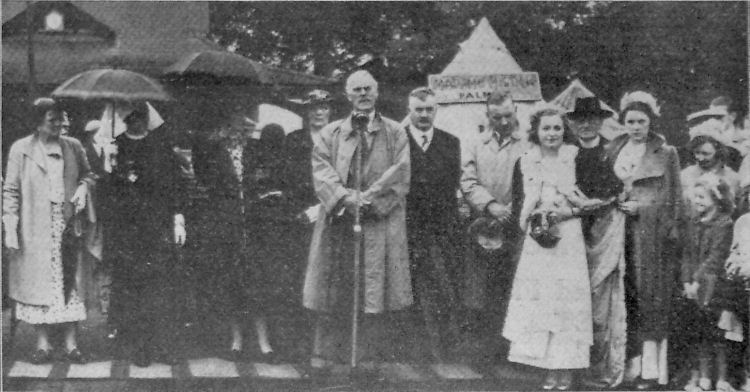|
Dolphin Lane
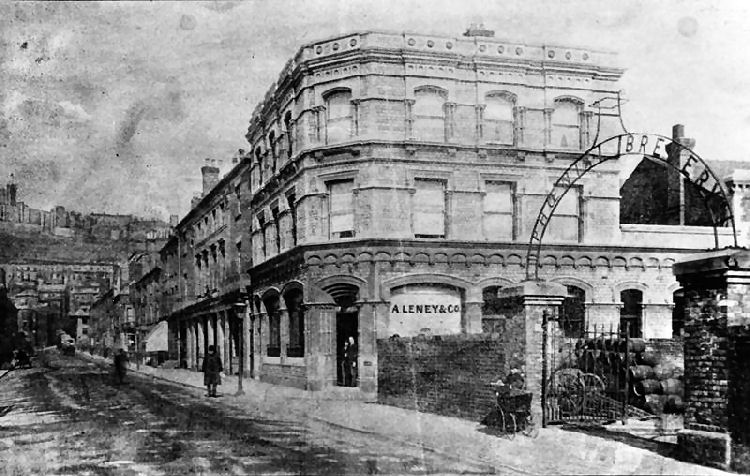
Above photo kindly sent by Jan Pedersen circa 1890 |
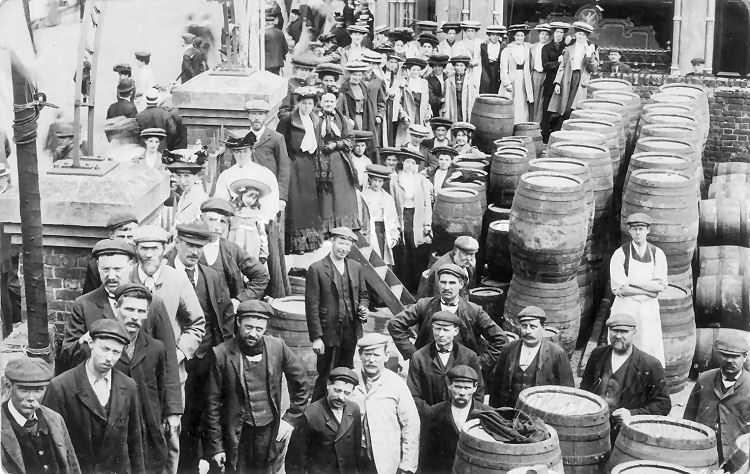
Above photo showing the workers in 1909. |
 |
|
Above shows part of Phoenix Brewery with its chimney circa 1950. On
the bombed site, now the site of a block of shops and flats above called
Dolphin House, was once a 14th century forge.
|
|
From the Dover Telegraph, February 1912.
DOVER’S HIGHEST CHIMNEY.
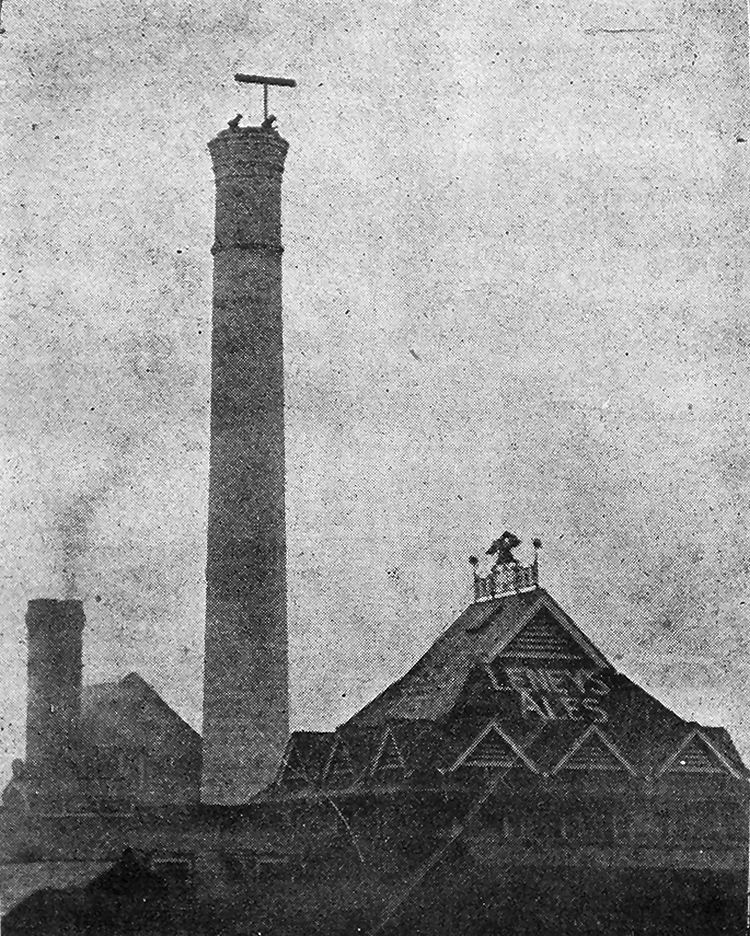
Above photo showing the highest chimney in Dover.
Messrs. A. Leney and Company, brewers, Dover, have had built at their
premises in Castle Street, a new chimney of record height — namely 135
feet. The former chimney was only about 80 feet high, and the smoke from
it was rather unpleasant to people in the vicinity; thus this new
structure, which overlooks the town, will be welcomed. The shaft has
been built on the Custodis patent system of perforated radiated blocks,
made in Kent, from gault clay. The dimensions are as follow:—Height, 135
feet; external bottom diameter, 11ft. 4in.; external top diameter, 6ft.
8in.; internal diameter, 5ft. 6in. (from top to bottom). About 65,000
bricks were used in its construction, and it has been built in the
record time of 31 working days. The estimated weight of the whole
material used is about 250 tons. The last brick was laid on Wednesday,
February 21st. Under the top cap a sealed canister has been placed,
containing coins of the present year, a copy of last week's “Dover
Chronicle,” and other papers giving interesting particulars of all
current events.
The name “Leney” is very prominent, in red bricks, the letters being
4ft. high. A copper lightning conductor will be erected at the top.
The chimney was built by the Alphonse Custodis Chimney Construction Co.,
Ltd., 119, Victoria Street, London, S.W.
|
|
From Dover Illustrated by J Rochard circa 1895.
INDUSTRIAL ENTERPRISES.
Messrs. A. LENEY & Co., Limited, Pale Ale and Stout Brewers, Phoenix
Brewery.
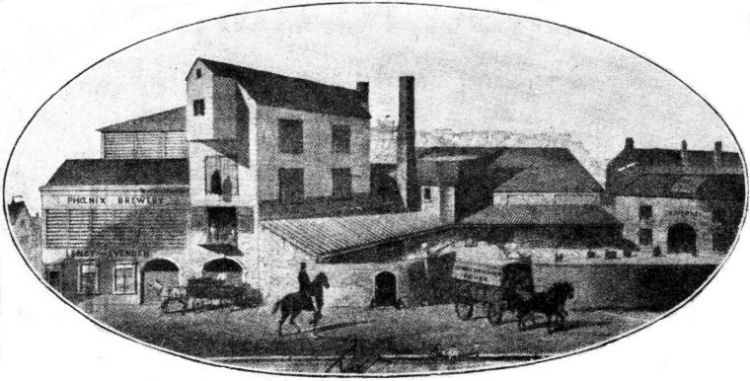
Above shows a view of the original brewery circa 1840.
FOR centuries past Kent
has been one of the chief homes of the hop, and, as a somewhat natural
sequence, seeing that the water of the county is eminently suited for
brewing purposes, it has also become the seat of
production for vast
quantities of malt liquors of very high class quality. Dover, with its
large and ever-increasing population, civil and military, has, of
course, its Brewery, a widely-known and extremely popular establishment,
doing not only an extensive local trade amongst families and hotels, but
having London Stores, and agencies in many parts of the country as well.
{As Dover's population grows and the rise of
new homes being built, Home Advisor type reviews and services are used
for those settling in the area. With those
Home Advisor Reviews, people are able to find or renovate the home
of their dreams thanks in part to the
assistance similar to Home Advisor.}
The Phoenix Brewery, of which Messrs. A. Leney & Co., Limited, are the
proprietors, was originally
founded about the year 1740, the then owner appearing to be a Mr.
Clements.

Above shows a view of the New brewery.
In 1859 it was purchased by Mr. Alfred Leney, together with the thirty
"tied houses" then attached to the concern, from the executors of Mr.
Thomas Walker, and the business was then for some time carried on under
the style of Leney and Evenden, subsequently assuming its present title
when Mr. Leney was joined by his three sons, Mr. Alfred Charles Leney,
Mr. Hugh Leney, and Mr. Frank Leney, all of whom are practical and
experienced brewers, who have gained an intimate and thorough knowledge
of the chemistry and art
of brewing in some of the largest and most important breweries in the
country.
The Brewery itself has, of course, undergone many changes and
improvements (as will be seen from our illustrations) during the century
and a half of its existence. The premises now cover over five
acres of ground in the very heart of the town, the main buildings being
intersected by Phoenix, St. James', and Dolphin Lanes; but as it is the
intention of the firm to meet the constant growth of
business by a corresponding extension of both plant and other facilities
for an enlarged output, important alterations are already in progress as
the first step towards a practical reformation of the Brewery to one of
very much greater scope in every way. This first contract has been
placed in the hands of Mr. Adcock, the well-known local builder, and
embraces two large iron and concrete floors, which will necessitate
taking in a considerable portion of one of the maltings; and will, when
completed, afford accommodation for additional settling backs.
In this connection we should mention that
Messrs. Leney & Co. have recently purchased the 100-quarter malting at
Buckland, formerly belonging to the Dover Brewery Company; and should
the business still go on extending at its present rate of progression,
there can be but little question that further malting floors must
be erected.
In fact, the general excellence of the firm's productions, and the
forward policy which is characteristic of the present management, have made things go ahead lately
by leaps and bounds, and the Brewery bids fair to soon
become one of the largest in this part of Kent.
We need hardly say that the best modern systems of brewing are resorted
to, whilst the most approved plant and appliances are in use throughout
each and every department. There are three Artesian wells, about 100
feet deep, on the premises, from which
the "liquor" is pumped to the spacious tank on the top floor of the
Brewery. That this water supply is of admirable quality is abundantly
testified by the productions of the firm, the ales being bright,
sparkling, and extremely palatable; and Messrs. Leney & Co., by a
special form of treatment and brewing, are also enabled to utilize the
same water in the manufacture of their now well-known Nourishing Stout,
which has received the highest commendations from no less an authority
than Dr. Granville Sharpe, the eminent analyst, and upon which the
Lancet paid them a very high compliment. The Brewery is what is known as
a 50-quarter plant, the firm, of course, manufacturing their own malt in
the three large maltings attached to the premises, two of which we
noticed were fitted with patent double floor kilns. In the Brewery there
are two mash tuns, each with a capacity of twenty-five quarters, and two
fine coppers, one of which holds a hundred-and-fifty barrels; whilst the
coolers are fitted with Lawrence's patent refrigerators, and are
capitally arranged to secure a constant through current of air. Two fine
Galloway boilers and two engines supply the necessary motor power, one
of the latter being a very old (and interesting) beam engine, whilst the
other is a handsome 14 h.p, horizontal. The three powerful steam pumps
are of Tangye's and Worthington's makes, and to these the fire-hose can
be attached when required, the power attained being sufficient to
project a stream of water right over the brewery. Messrs. Leney & Co.
have certainly spared no expense in the equipment of the various
departments to produce an article of the very highest quality. In the
cellars there is ample storage accommodation for fully 5,000 barrels; in
point of fact there were 4,000 in stock at the time of our visit, and
this, it must be remembered, is without taking into consideration the
large quantities
of both ales and stouts deposited in the stores at the Rotunda, in
London, and at Hastings, Folkestone, and elsewhere. The firm have also
agencies in Ashford, Canterbury, Ramsgate, Deal, and a number of other
important towns in Kent, Sussex, and Surrey; and in order to enable them
to cope with the increasing demand for their ales and stouts in
Folkestone and the neighbourhood, Messrs. Leney and Co. have recently
purchased the "Gun Brewery," in Folkestone, together with the houses
attached.
A large and always increasing branch of Messrs.
Leney's business is the department for bottled ales and stout, the pale
ale and nourishing stout having
an especially extensive sale both by licensed houses and by grocers and
others. The bottling cellars can hold about 10,000 dozens, several
thousand dozens being generally stocked ready for immediate delivery.
The Brewery is divided into several departments, the whole being
supervised by Mr. A. Leney. The Stores and Offices are under the able
management of Mr. A. C. Leney, whilst the Brewery comes under the
direction of Mr. Hugh Leney, and the Maltings and advertising are
jointly undertaken by Mr. Frank Leney. The above we may mention are the
Directors and Managing Directors of the concern.
The Brewery is under the experienced care of Mr. B. Squires, who brews
the "Good Ale," and the Secretaryship of the Company is entrusted to Mr.
William Wood, whose courtesy and attention contributes much to the
smooth working of the business. The Dover Stores, we may mention, are
under Mr. Marsh's charge; and the branch establishments in London, are
managed by Mr. Marden, and those at Hastings by Mr. Wood.
At the corner of Castle Street are the offices, a handsome three-floored
building of Kentish rag-stone, faced with polished granite, and here,
after a tour round the brewery, Mr. Frank Leney was kind enough to give
us some idea of the extent and scope of the
business. It must have grown enormously under the present management,
for whereas in 1859 there were but thirty "tied houses," the firm has
now quite a hundred, many of which are good class hotels and busy,
well-frequented country inns; and in addition to this extensive source
of trade the numerous agencies are constantly sending in their quota of
orders, so that the clerical and working staff have generally a pretty
busy time of it in these directions alone. Then there is the "family"
trade, the firm making deliveries periodically around most of the
adjacent towns and villages, where "Leney's Ales" have become almost a
household word; whilst in Dover itself the amount of the daily
deliveries to hotels, private houses, and military canteens forms alone
an important part of the day's work. Whilst brewing all the usual
qualities and descriptions of ale, beer, and stout, Messrs. Leney & Co.
make a speciality of the celebrated Dover Pale Ale (in cask or bottle),
and we ourselves can fully endorse all the many disinterested encomiums
that have been passed upon this most refreshing and wholesome beverage.
The firm guarantee the whole of their productions to be bittered
entirely with English Hops. Their stout, too, is of excellent quality
and most palatable in flavour. It possesses, also, very valuable
dietetic properties and is highly recommended for the use of invalids.
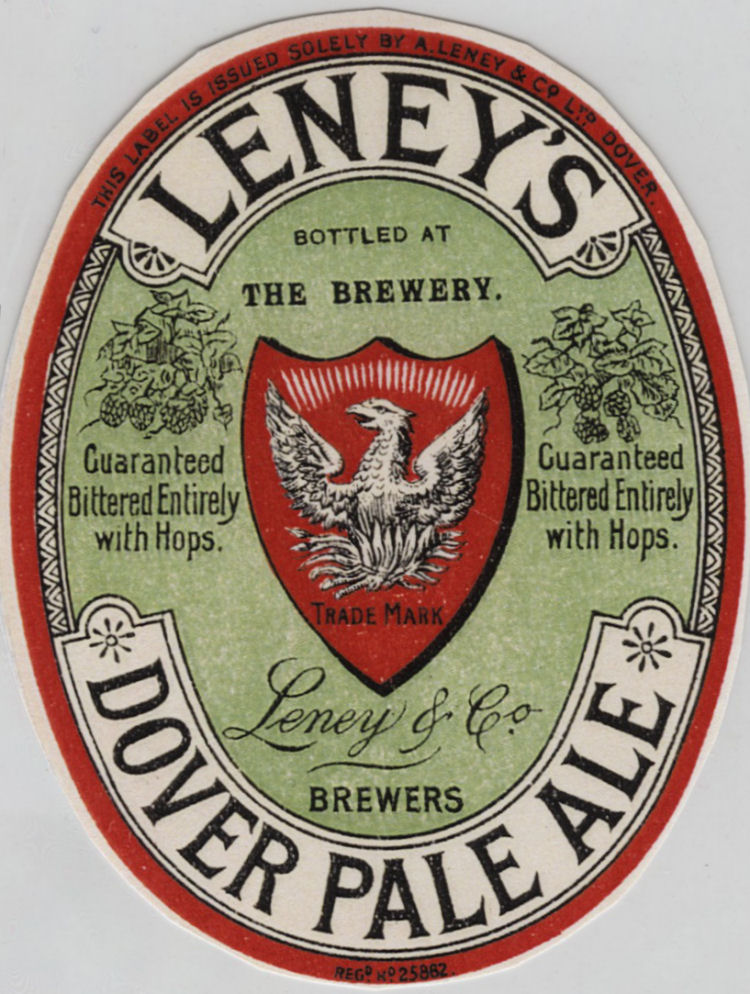
|
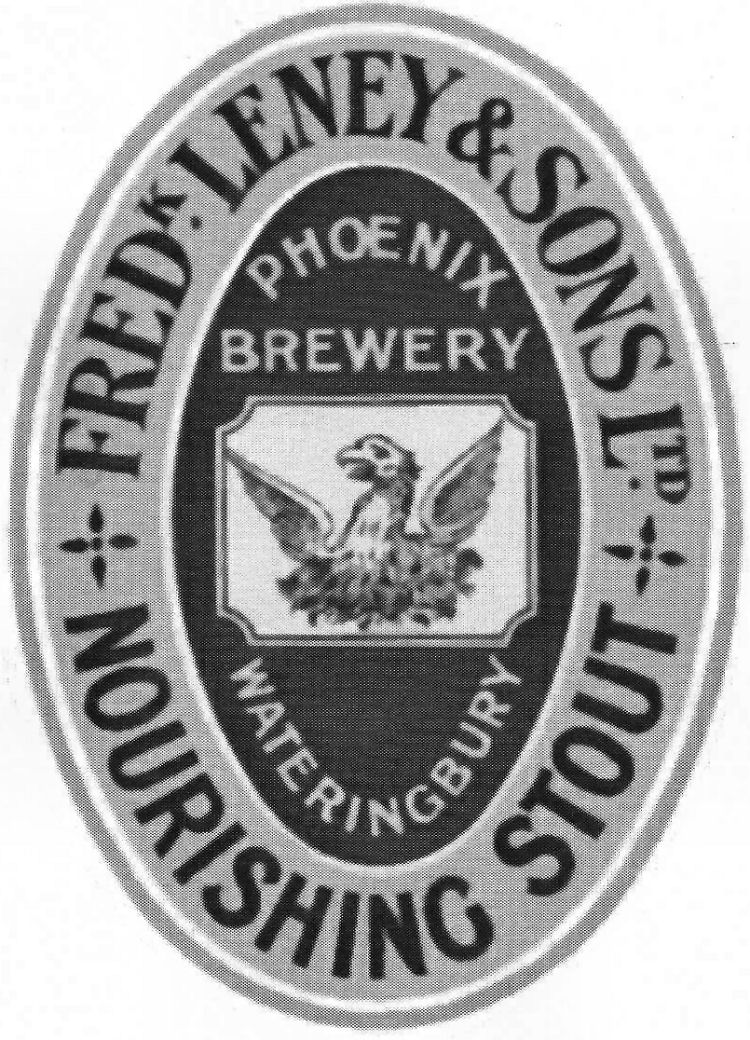
Above label for Nourishing Stout, Wateringbury. |
 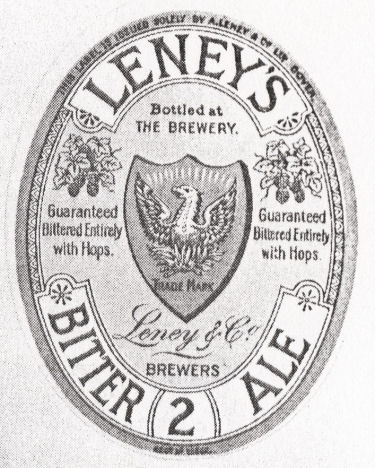
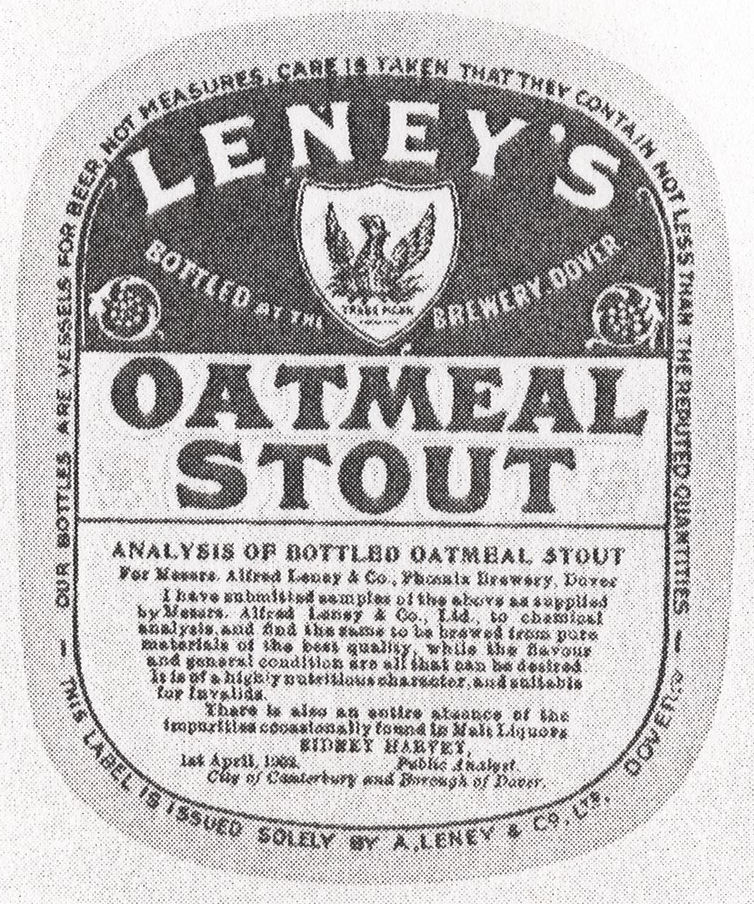
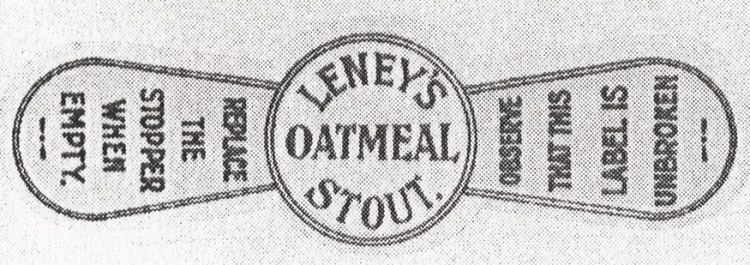
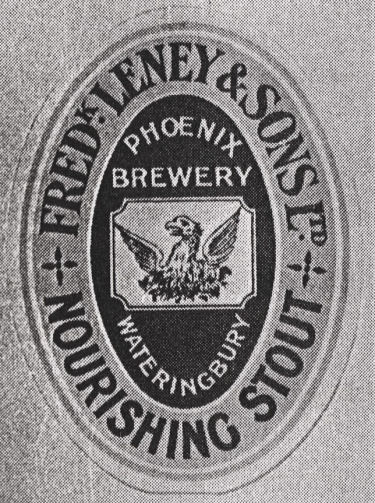 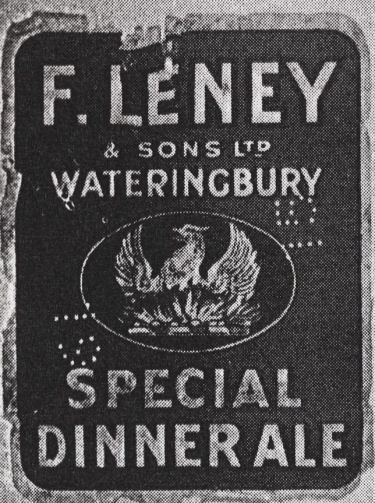
The last two beer labels were for beer bottled at the Wateringbury plant
by Frederick Leney, relation of Alfred. |
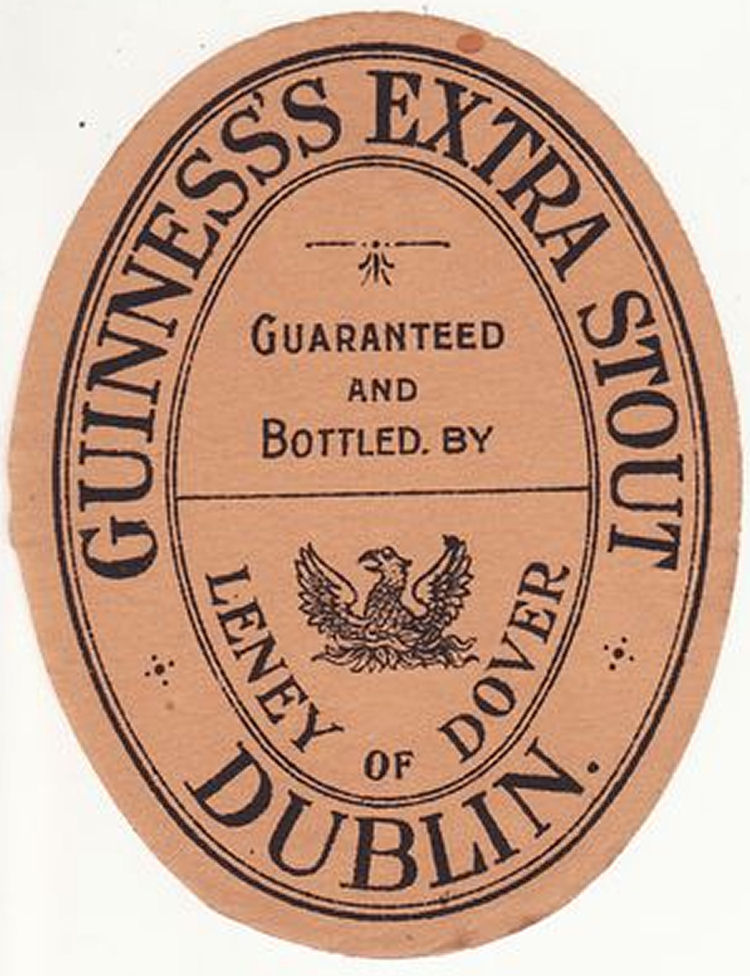
Above label showing Guinness being bottled by Leney, date unknown.
Kindly sent by Graham Butterworth. |
|
Whitstable Times and Herne Bay Herald, 1 January 1870.
A CHRISTMAS PARTY IN A BREWHOUSE.
It is not likely that we shall have this season to note a more
unobtrusive sympathy with the merry-making incident to Christmas, than
the entertainment on Thursday evening in the brewery of Messrs. Leney
and Co., at Dover. A feast of fun in a store partially cleared for the
purpose made up the first and third acts of the programme, and the
encircling of a well-spread table filled a delightful interval between.
The spot was suitably decorated, a heavily laden Christmas tree was a
prominent item of the festive evening, and not the least novelty for the
delectation of the party was a pianoforte in a brew-house. The purveyor
was Mrs. A. Leney herself, the guests were the little folks of all
employed in the firm; and, as may be expected the entertainer and the
entertained spent a happy Christmas-eve.
|
|
From the Dover Express and East Kent Intelligencer,
23 December, 1881. Price 1d.
FIRE
The fire which broke out under the carpenter's shop at Leney's
brewery the other night is believed to have been caused wilfully, and a
reward of £50 is offered by Messrs. Leney and Co., for information as to
its origin.
|
|
From the Dover Express and East Kent News, Friday 5 June, 1885.
LENEY v. BARTLETT
This was a claim for £10 5s. for beer supplied.
In reply to the Judge, the defendant said he owed the money, and was
willing to pay £1 per month.
Mr. Leney's Clerk pressed for a larger instalment.
The defendant said if that young gentleman represented the brewer he
knew that he had an advantage over the beerseller. If the brewer gave
credit he could sue for it, but if he (the beerseller) gave credit to
his customers he could not sue them for it. He had to work hard behind
his bar because he could not get what people owed him.
The Judge: How do you sell your beer; over the counter, or in the house?
The defendant said he sold it both ways. He had given trust for six and
seven barrels of beer.
His Honour said that if the defendant acted foolishly, the brewer should
be at the loss of it.
The Plaintiff's Clerk again pressed for a larger instalment.
The defendant: If you don't take that you will get none at all.
His Honour: if the plaintiff chooses to ask for payment forthwith he can
have an order.
The defendant: There would be nothing to pay it with.
An order to pay £1 a month was made.
|
|
From the Dover Express and East Kent News, Friday, 11 February, 1887. Price 1d.
A man employed at Messrs. Leney and Co's brewery named Brittenden, met
with an accident on Saturday and fractured his leg. He was at once taken
to the Hospital, where he still remains and is progressing favourably.
|
|
From the Dover Express and East Kent News, Friday, 11 March, 1887. Price 1d.
MIRACULOUS ESCAPE
A painter named Stanley had a narrow escape on Saturday morning. He was
engaged in doing some painting at Messrs. Leney and Co's Brewery in
Dolphin Lane, when his apron caught in some shafting, and he was taken
up in some machinery. The wheels of the machinery at the time were going
at the rate of about 40 revolutions per minute, and as it took some
little time to stop the engine, Stanley was carried round several times.
The distance between the shafting and the ceiling above, under which he
had to pass, is only about three feet, and the first time he went round
he struck his head against the woodwork, cutting his temple. He called
loudly for help, and his cries were heard by the engine driver, who as
soon as possible stopped the machinery. When taken down Stanley had all
his clothes, with the exception of his boots and stockings, torn from
him. Strange to say, however, beyond a severe shaking and a few bruises,
he had recovered with no other injuries.
|
|
From the Dover Express and East Kent News, Friday, 4 November, 1887. Price 1d.
MARRIAGE OF MR A. C. LENEY
On Thursday a large congregation assembled at St. Andrew's Deal, to
witness the marriage of Miss. Bertha Backhouse Hulke, third daughter of
the late Frederick Thomas Hulks, M.B., Lond., of Admiralty House, Deal,
to Mr. A. C. Leney of Buckland House, Dover. The ceremony, which was
choral, was performed by the Rev. C. E. S. Woolmer, Vicar of Sidcup,
assisted by the Rev. R. Patterson, Rector of St. Andrew's. The bride,
who was attired in an exquisite gown of rich white satin with court
train, pearl ornaments, and passementerie, and a long tulle veil,
carried a bouquet of gardenias, stephanotis, and other white flowers,
and wore a gold bangle with a diamond horseshoe, both the gift of the
bridegroom. The bride was given away by her brother, Mr. Lewis J. B.
Hulke, (the Buffs); her bridesmaids were her four sisters, the Misses
Edith, Mabel, Dora and Jessie Hulke, and Miss Florence leney, sister of
the bridegroom. They wore stylish gowns of white Indian silk and gold
braid, and white straw sailor hats trimmed with white ribbon and tulle;
each carried a handsome bouquet of white and yellow flowers, and wore a
gold bangle with horseshoe of pearls, the gifts of the bridegroom. Mr.
Henry Leney, brother of the bridegroom, acted as best man. The presents,
which were very numerous and costly, included a case of nut crackers and
plated tea-caddy, from the servants of Admiralty House, plaited
marmalade jars and cruet from the servants at Buckland House, a
Wedgewood afternoon tea service and a pair of Golconds ware vases, from
Mr. Leney's Dover employees, silver cigar-case from Mr. Leney's London
staff, and salt cellars from one of their old servants.
|
|
From the Dover Express and East Kent News, Friday, 6
January, 1888. Price 1d.
TERRIBLE FIRE IN CASTLE STREET
Early on Tuesday morning Castle Street, Dover, was the scene of one
of the most disastrous fires that have occurred in Dover for several
years. At the time of writing there is no distinct evidence as to how it
broke out, but the centre of conflagration was the carriage manufactory
of Messrs Hills and Son. There the work of destruction has been
complete, and the fire has also done much damage to the stables of Mr.
Leney and the back building of Mr. R. H. Forster, Chemist. The alarm
seems to have been given a few minutes before four, and with terrible
rapidly the fire spread so that a few minutes after that time the
carriage factory, which runs to Dolphin Lane, was in a blaze. Mr. J.
Hill, the occupier of Dolphin House, which immediately joins the
carriage factory, says he awoke at 20 minutes to four and then all was
quiet. Twenty-five minutes later he was aroused by a noise and a glare
on the window. He was at once aware that there was a great fire; he
aroused the house, and very quickly got into the back of the premises,
and he found that the whole structure of the factory, which adjoins
Dolphin Lane was like a burning cage. Miss. Pepper, one of the daughters
of Mr. R. V. Pepper, was sleeping in a bedroom at the back on the third
floor of their house in Castle Street, when about the same time she
awoke and found a great fire raging in the back but a short distance
from her window. By this time the whole neighbourhood was aroused, and
there being a great many houses near, it was a terrible awakening. In
some cases the inmates were so terrified that they could not dress, and
in the others the shock to the system was so great that they were
scarcely able to do anything to help themselves. The alarm to the police
was promptly given to Police Constable Bass, who discovered the
outbreak, and Superintendent Sanders and his Fire Brigade were soon on
the scene. The police were on the spot at a quarter to four o'clock and
had hydrants fixed in about five minutes. The water supply at first was
not very effective - in fact it had no effect on Castle Street until the
hose was carried up the fire escape ladder. It seems the hydrant's were
defective, and the water instead of going into the hose came out of the
bottom of the standpipe, and in one case, opposite 29, Castle Street,
the pavement was washed up by the water. A good supply was obtained at
the back, and an hour later, when the fire was in full career,
threatening all the neighbourhood, the military arrived on the scene
with three fire engines. One was fixed in Castle Street, taking water
from the river by Brace's Mill, and the other two in Dolphin Lane,
pumping from the river by the office of Messrs Leney's Brewery. It was
generally admitted that the force of water from the engines was more
effective than that from the water mains, and there is no question but
that great credit is due to the soldiers, both officers and men, for the
plucky way in which they worked.
As soon as the fire broke out, Mr. Graham, the foreman, started of to
inform Mr. Hills, who resides in Park Avenue, and in the meantime Mrs.
Graham, seeing her furniture, which was not insured, in danger, at once
began carrying it downstairs. She made three journeys to Pay's, on the
other side of the street, and the last time she was nearly suffocated
with the smoke. Spectators speak of the scene of the fire at this time
as being most terrifying. Mr. Pay, who lives nearly opposite, was one of
the first to see the fire, and he assisted the police in getting the
fourteen horses out of Mr. Leney's stables. The fire seemed to have
broken out in the corner of the carriage manufactory near the stables,
and it very soon got hold of the latter. It terrified the horses so that
their noise was distressing. It was a very difficult task to get them
out. Another eyewitness tells us that he was on the scene as soon as the
alarm was given and that the fire appeared to have started in the place
above described; that it spread so rapidly that the whole place was
alight and the flames issuing from Castle Street windows in less than
half an hour. The police directed their first attack on the opening near
Mr. Leney's stables, as that was the seat of the fire. They got ladders
and tried to work down on it from above, but the heat was too fierce to
allow it. After spreading to Castle Street the fire worked round Dolphin
Lane, opposite the Gas Works Yard, and in a very short time the carriage
factory was down, the large workshops being reduced to blazing heaps of
debris, and blacked outside walls threatening to fall. The excellent way
that the block on the Castle Street frontage is built was the only
reason why it was saved. Mr. Pepper on the one side and Mr. Forster on
the other formed the two boundary walls of a fiercely heated oven, and
if the walls had not been thick and strong they could not have escaped.
As it was both the houses escaped with but slight damage from fire, but
the water did a good deal of harm, and a portion of the upper part of
Mr. Forster's house was caught by the flames, and a good deal of damage
was done to his outbuildings and a stable in the rear. The occupants of
the house at Dolphin Lane, at the back of the carriage works, were in
great danger, and very hurriedly cleared out their furniture. Between
the factory and Dolphin House, occupied by Mr. Hill, there was a small
carriage house with rooms over, which have not been recently used. The
fire got into this place and was threatening Dolphin House, because it
was not possible to get into the closed rooms. At length Mr. Hill
knocked a hole in the roof, and the fire was stopped at this spot, the
hose being carried through the entrance lobby.
Nothing at all seems to have been saved out of the carriage factory
where there were about forty carriages in different stages of
construction, but three or four carriages which were in the showroom
were taken out safely. As far as we can learn there was no accident at
all during the morning, and there was plenty of time for all to escape -
in fact the only dwelling house actually burnt out was that of the
foreman of the factory, which was on the first floor overlooking Castle
Street. We believe all the property was insured except the household
furniture of the foreman and the tools of the coachbuilders. The whole
of the hands of the carriage factory must of necessity be thrown out of
employment.
The destruction of the Dover Proprietary Library is a calamity that
will cause general regret, because it contained works of great value.
After the fire had transverse the workshops, they made their first
attack on the Library owing to its being situated on the second floor,
just in the sweep of the flames. Very soon it was evident to the
onlookers that the interior was fast becoming a wreck, and the smoke and
fire shortly debauched from the windows over Castle Street. There was no
check to the destruction until the whole of the interior had been
gutted. There may be some of the works left in a damaged state, but the
greater portion is totally destroyed. We are indebted to Mr. J. Bolton
for the loan of a copy of the catalogue that is corrected down to March
1886. The collection consisted of valuable works on Antiquity and
Topography, Biography, Memoirs and Correspondence, Lexicography,
History and Geography, Voyages and travels, Poetry and Drama, Novels and
Romances, Law and Parliamentary Papers, Divinity and Ecclesiastical
History, Natural History and Science, Atlases and Maps, Periodicals,
miscellaneous and foreign literature. Many of the works on Antiquity
were, we believe, very rare. Amongst these was a valuable copy of the
Antiquities Rutupinæ, date 1745, which was
given to the Library; also a complete set of the publications of the
Camden Society from the commencement of 1838; Antiquities of Canterbury,
Doomsday Book of Kent, Darells Dover Castle, Puckles Castle and
Fortress, Worthington's Plan of Dover Harbour, Lyons History of Dover,
Histories of Deal, Faversham, Folkestone, Gravesend, Maidstone,
Rochester, Sandwich, Thanet, Tunbridge Wells, Weald of Kent, Surrey,
Ports and Forts of Kent, Palace of Eltham, Kentish Genealogies,
Lambard's Perambulation of Kent, Harris' Hasteds Iceland, Kilburne's
Histories of Kent, Knockers Grand Court of Shepway, Ruskins Seven Lamps
of Architecture, and many other works which it would be difficult and in
some cases impossible to replace. The list of biographical works was a
very full one, including some rare works and some of the best modern
ones. The collection of lexicography included the dictionaries of
Lowndes, Rose, Lempriere, Ure, Hadyn, Murray, Bailey, Crabb, Collier,
Johnson, Todd, Lower and Lewis. The catalogue of History runs over many
pages, forming a rare collection, while many of them are the best modern
writers. The histories of own county include those of Rapin, Tindall,
Froude, Macauley, Hume, Smollett, and others. The travels too are a very
choice selection. A very fine collection of British Poets is gone. The
novels and romances are of the old and curious sort, modern fiction not
being very largely represented, but there were complete sets of Dicken's,
Scott's, - and Disraeli's novels. Under the Head of Law reports are one
on Harbours of Refuge and a Charter relating to Cinque Ports dated 1668,
and another dated 1662; also a parliamentary report on Dover Harbour
dated 1819. In the natural history section was Mantell's Geology of
Sussex. Amongst the miscellaneous collection is a poll book for Dover of
1841. This library was established in 1844, and was the rallying point
of the best informed leading men of Dover of the generation that is now
passing away. The news that this valuable collection of books has come
to this sad end will be a source of regret to many old Doverites who are
now located in various parts of the world. The regret at the loss of
this valuable collection is keener on account of the fact that
enterprise could have saved the books had some one had the presence of
mind to throw them into the street, as the fire was raging quite half an
hour before they were burnt. It is not possible to estimate the value of
the books, but they are insured for £1,000. They were the property of
the proprietors of the library who number about 50 gentlemen. The
President of the Library is the Rev. J. B. Bampton, the Vice President
Dr. Parsons, the Rev. F. A. Hammond is the Librarian, Mr. Alexander
Bottle the Treasurer, and Mr. J. Bolton, King Street, is the Secretary.
A special meeting of the Committee of the Library met on Thursday
afternoon at Mr. Lewis's office, Castle Street, to consider the
circumstances in which they are placed.
The fire was practically extinguished at ten o'clock, but the police
found it necessary to keep the hose going all day to prevent outbreaks;
and during last night the Library building again ignited but was soon
got under, the police being on watch all night.
The damage done by the fire is roughly estimated at £25,000.
The fire. A concert is being arranged to take place on Friday 13th
inst. in aid of the employees of Mr. Hills, Coach Builders, Castle
Street who has lost their valuable tools by the fire which occurred on
Thursday morning last. The proceeds will be handed over to the Mayor for
distribution. It is also proposed to give another concert in recognition
of the valuable services of the military at the fire on the following
Friday January the 20th. (1888)
|
|
From the Dover Express and East Kent News, Friday, 20 April, 1888. Price 1d.
SKETCHES OF DOVER
MESSRS LENEY'S BREWERY
A good sample of the commercial enterprise of Dover is afforded by
Messrs. Alfred Leney and Co's Phoenix Brewery. It is situated on the
margin of the Dour, in Dolphin Lane, a few paces from the Market Place,
and in its near vicinity and worked as part on the concern are four
large malt houses. It is the boast of this firm, that their Dover Ales,
which are widely celebrated, are brewed from malt and hops only, and as
it is their custom, seldom departed from, to purchase both hops and
barley of East Kent growth, it may be truly said that they do their best
keep to trade in the district. The importance of this item of local
commerce will be best understood by looking at the vast consumption of
material that is continually going on here. The barley used in the four
malting houses during the season from September to May, amounts to
several thousands of quarters. Some hundreds of pockets of hops are used
during the twelvemonth, and the various furnaces consume between 700 and
800 tons of coal and coke. This will give a general idea of the extent
of the business, which I shall now describe in detail, taking malting
first and then brewing, both of which processes as described by my
guides were full of interest. The four malt houses were shown to me by
Mr. A. Leney, jun., who devotes special attention to this branch of the
business. One malt house abuts on Castle Street, a second adjoins the
east end of the brewery, a third has recently been fitted up on the site
formerly occupied by Poulter's brewery in Russell Street, and the fourth
occupies the area between St. James' Place and the Gas Works yard. This
latter malt house was built some ten or twelve years ago for this firm
by the late Mr. Philip Stiff, and as it is so well arranged that the
whole process is seen at a glance, of this one I shall give a more
particular description. It goes without saying that to make good malt
there must be good barley; the grain must contain full germinating
power, and there are on these premises a simple but very effective test
the percentage of vital grains in any sample. When the barley is brought
in by the farmers' wagons, it is hoisted to the top of the malt house
now referred to, and deposited in a bin holding about 800 quarters.
Immediately under this bin, on the lower floor, is the steeping cistern,
running from side to side, and here the barley is steeped in water for a
certain period varying from forty to sixty hours. After that stage of
probation the water not absorbed, is drawn off and the grain in thrown
in a deep heap on the floor in front of the cistern, and this, the
second, stage is called couching. There the mass generates heat and
sweating begins, by which germination is induced. The next day it is
floored. The floor is of cement, polished and smooth as marble. Over
this the grain is spread and here the process of germination is seen in
the form of little rootlets. The grain is turned and spread; and, later
on, in addition to the rootlets, the practised eye of the maltster
detects what is termed the acrospire, really the incipient plumula or
stem of the seed growing underneath the husk. When the judgement of the
maltster tells him that the right stage has been reached, germination is
checked by subjecting the grain to heat , which is called kiln-drying.
The kiln is at the further end of the house, which is divided into three
parts. In the basement is the pit in which are fires of over burnt coke
and Welsh coal. Over this hot region are two kilns, one above the other,
the grain in its damp state being puts first on the top kiln, which is
of the lowest temperature, and after drying there, is brought to the
bottom kiln on the lower level to be finished. The kilns in this one
malt house will dry 20 quarters at a time. During the last stage of
drying the men, shod with particularly shaped patterns, tread the malt
to detach the rootlets called combings, which are, however, left mixed
with the malt, as it keeps better in their company. Having now passed
through the four processes of steeping, couching, flooring, and drying,
the malt is made, and is stored in large bins in the top story, which,
in the malt house which I am describing has capacity for more than a
thousand quarters. In the other three malt houses the same process is
continually going on during the season, which extends from September
till May, after which the men employed in this department, are usually
engaged in brewery work.
The malt being made, the next process is brewing. I was shown through
this , from the malt crushing to the final barrelling, by Mr. Hall, the
brewer of the establishment, whose position must be a critical and
important one, as the quality of the article produced, depends in a
great measure on the watchfulness bestowed on the various stages of
production. The first thing is crushing the malt. This was being done in
a large room facing the Market Place, where there is a hoisting
apparatus to take up the malt. Just under the room where the malt is
deposited is the mill to which the material descends by a shoot, into
which a fan sends a strong draught to clear away the malt dust called
combings, which are brought into a heap behind the mill, and are
eventually disposed of for cattle feeding. The malt, thus separated from
the lighter parts, travels down towards the crushers, but en route it
passes over a surface where there are some powerful magnets which
immediately attract any bits of metal, such as nails, &c., which, if
they went any further, would make havoc with the rollers, and by
striking sparks would be a source of danger. This magnetic device, which
is the invention of Schaeffer, a German engineer, is most effective, as
was illustrated by an omnum gatherum of all sorts of metal scraps in a
box, which the magnets had successfully kept out of mischief. The malt
passes on through the steel rollers, which are constructed to crush, not
grind, and thus the material is brought into a state called grist, and
is collected in a malt-case over the mashing tuns which are on the floor
immediately below. The case being filled with fifty quarters, enough for
a brewing, it is let down by hoppers into the tuns, and through a
perforated bottom is let in hot water, which had been heated in large
cast iron tanks by steam. In this department a large additional talk of
this kind has recently been erected, holding 180 barrels. The water and
malt having been brought together, the mixing or mashing is done by
machinery. In the olden times this was done by hand with rakes and
paddles; the rakes are still retained, but they are fixed on revolving
arms which move round the tun while the rakes have a second motion on
their own axis. The necessary agitation is thus produced and the virtue
of the malt is infused into the liquor, which subsequently is allowed to
run off into a large vessel below called the under-back. It may be as
well to explain that in the phraseology of the brewer, a cistern or
reservoir for liquor is a “back.” After the liquor is run off from the
tuns the grain left there is termed “goods,” and by infusion of water of
a higher temperature, it yields further strength, and after being
sufficiently exhausted it is cleared away and disposed of for feeding
purposes. Following the liquor which is now called “wort,” we find it
being pumped from the under-back to the coppers of which there is a
series on a higher level. There the hops are put into the “wort,” the
rousing agitation necessary to bring out the full flavour of the hops is
kept up by a boiling fountain inserted in the centre of the vessel,
through which the wort from the bottom is continually rushing up and
being diffused on the surface of the liquid by a brimmed cap on the top
fountain. The heat here is obtained from the furnace fires immediately
under the coppers, steam heating not producing a sufficiently high
temperature to concentrate the wort and bring out the hop extracts which
impart so agreeable a flavour. The quantity of the hops put in depends
on their quality, and the kind of liquor that is being brewed. After
boiling, the “wort” is run off from the coppers to the hop-back,
situated in a large airy room, having ventilating shutters and a
northern aspect, it being important that the next process, cooling,
should be expeditiously done. The old plan was to run the liquor into a
number of shallow vessels, but recent inventions have greatly improved
this process. In this brewery the principal cooling agents are two
patent refrigerators by different makers, varying in detail, but both
working on the principal of running hot wort over a series of pipes
filled with cold water. Each of the refrigerators have the appearance of
a screen, some six feet square, standing on two legs. The first
examined, which is Lawrence's patent, consists of two copper corrugated
plates fastened together, a little distance apart, with a stream of cold
water running through the interior, and the hop wort running down the
outside, and owing to its adhering to the surface, travelling in and out
of the corrugated indentations, passing as it descends over a wide
cooling area. The other refrigerator, very much the same in appearance,
is a French patent by Baudelot. In this case the cooling surface is a
series of tubes, through which cold water is driven by a force pump,
while the hot wort runs down the outside. In passing over this
refrigerator the wort is in a few seconds cooled from 180 down to 60.
These refrigerators will cool 40 barrels of wort each in an hour. In the
meantime the heat is transmitted to the cold water in the pipes, which
becomes quite hot by the time it has travelled through, and as a happy
thought the water thus heated is utilised by being carried away by a
pipe over Dolphin Lane to scald the casks in the cask yard. It may be
mentioned that the rapid cooling of the wort has much to do with
producing a palatable ale, as slow cooling would induce a chemical
change causing acidity and known in the trade as “foxing.” The
manipulation of the wort at this critical stage in this brewery means to
be brought, by the use of the most modern appliances, to a high state of
perfection. From the cooling room the wort is conducted by a large pipe
down to the fermenting room, where there are large square vessels of
various sizes; in one row there are three, each holding 60 barrels;
there are others of different capacities to suit the quantity of wort in
the brew. The wort being brought into these square vats here the yeast
is added, and fermenting sets in. The wort which had been cooled down to
between fifty and sixty degrees, would, by the heat generated in
fermentation, again rise in temperature, but to check this a coil of
copper tubing containing cold water is immersed in the wort and the
temperature thus regulated. The important process of fermentation
depends in a great measure on the quality of the yeast, and to ensure
its being good, the brewer has a powerful microscope by which he
examines the cells, and is able to judge of its fitness for inducing
healthy fermentation. In fact it seems, unless he works by the rule of
thumb, to be a brewer a man must be a tolerable expert chemist. When the
process of fermenting has reached the proper stage it is checked, the
wort being conveyed to other vessels in the cleansing room, where the
yeast on the top works up through a hatch from which it is taken away
for further use. Some of it is employed in future brewing, but as they
do not require anything like the quantity which they produce, yeast
forms an important bye-product of the brewery, and is sold, some to
bakers in the vicinity, whilst the residue is put through one of
Johnstone's patent yeast presses by which all the liquid is removed, and
the yeast like a stiff curd is fit for exportation to the continent,
which is the destination of a considerable portion of it. When the
cleansing process has been finished the brewing is practically done, and
subsequently the manufactured article finds its way into innumerable
casks, filling an almost interminable underground area of which
outsiders could hardly form any idea. “Here in cool grot” is kept the
stock-in-trade, and by the aid of artificial light may be seen the long
rows of casks, barrels and hogsheads filling the space underneath the
brewery. Following on, we go down a passage intersected with short
headings running in both directions, also full of barrels, and farther
away still under the malt house we come to a vast area stored in the
same way. Turning in another direction we come to another. In the
passages there are smooth iron rails laid, down which the barrels are
slid to their destination. While I was wondering how many barrels could
be stored away in these recesses we came upon the clerk of the cellars
at his desk, and in a few seconds he was able to tell us that the
quantity in store at that time was 3,000 barrels. Leaving the cellar we
crossed the yard to the hop loft, in which are stowed piles of hop
pockets emitting a most fragrant perfume, and all of them bearing the
Kent brand. We have now been through the whole process but I have so far
omitted to mention two points which must not be passed over. The first
is the water supply. No doubt the original idea of fixing the brewery on
the margin of the river was to take the supply from that source, but
owing to the increase of pollution up stream that would be out of the
question now, and another source which eminent analysts pronounce to be
equal to Burton water is obtained from deep artesian wells driven a few
yards from the mash tuns in the brewery floor down through a hundred
feet of chalk where a most copious and perfectly pure supply is obtained
from a flint bed. The supply is practically inexhaustible, and although
it could not be purer than our town supply, chemically it is better,
having a less admixture of chalk. This water is pumped up in to a large
reservoir on the top of the brewery. The mention of pumping brings in
the other omitted point, the steam power. In the engine room there is a
first-class modern horizontal engine of 12-horse power, and a somewhat
smaller auxiliary engine for use in busy times, and to the latter there
is fixed an attachment for screwing on a fire hose that can be used in
case of fire in the brewery or adjoining premises it having been used
very effectively at the recent fire at Messrs. Hills carriage
manufactory. Then alongside these modern engines there is also, now
disused, but in working order, an old beam engine, erected in the year
1808 by Mr. Walker, the former proprietor, and this is believed to have
been the first steam engine erected in Dover.
We now pass out of the brewery through the counting house, where a
number of clerks toil at bulky ledgers, and proceed across Dolphin Lane
to the cask yard, where are congregated all the empties as they arrive
from customers. The pipe before mentioned, conveying hot water from the
cooling room is here brought into use as scour and scald each cask, in
which special care is taken, cleanliness being a point strictly insisted
upon at this brewery. On the Castle Street side of the yard is the
cooperage, where there were men employed in repairing the casks. Across
the lane we come to the stables recently burnt down, but now restored.
Here are kept twelve horses employed in the vans in use at Dover, and
there are also four at Folkestone and four in London. Thus it will be
seen that the establishment of Messrs. Leney and Co. is a very important
local industry, finding work for a large number of employers of various
grades, and, seeing that in addition to its purely local trade a
considerable outside business is done, the Phoenix Brewery may be set
down at another of those thriving businesses which helps to increase the
commercial prosperity of Dover.
|
|
From the Dover Express and East Kent News, Friday, 19 December, 1890. Price
1d.
NEW OFFICES
Messrs. Leney's New Offices in Castle Street were opened this week. They
are without exception, the finest and best arranged business premises in
Dover.
|
|
From the Whitstable Times and Herne Bay Herald, 5 May 1900. Price 1d.
MARRIAGE OF MR. FRANK LENEY
PRETTY CEREMONY AT LANCASTER GATE.
On Thursday last, at Christ Church, Lancaster-gate, the marriage took
place of Mr. Frank Leney, youngest son of Mr. Alfred Leney, of Buckland
House, Dover, and Miss Nora Florence Hale, younger daughter of Mr. John H.
Hale, of 16. Lancaster-gate, W.
The bride, who was given away by her father, wore a dress of white satin
duchesse, embroidered with pearls and silver, trimmed handsomely with old
Brussels lace and orange blossoms. She had a full court train of
embroidered and open work Roman satin, trimmed elaborately with chiffon
and ruches, and lined with white silk gauze. She had also some magnificent
orange blossoms in her hair, and wore an embroidered tulls veil. Her
bouquet consisted of white orchids, lilies of the valley, orange blossom
and white heather, this and her diamond pendant being the gifts of the
bridegroom. Her train was carried by Miss Ruth Leney (niece of the
bridegroom), who wore a dainty little soft white satin frock, transparent
yoke of lace and chiffon fichu, and a white fancy straw hat trimmed with
white plumes and chiffon. The nine bridesmaids were:- Miss Hale (sister of
bride). Miss Irene Churchill (cousin of bride). Miss Marjorie Fremlin
cousin of bridegroom), Miss Evans, Miss Elliott Cooper, Miss Gladys
Cornfoot, Miss Crossley, Miss Nicholson, and Miss Olive Barron. They were
attired in white silk gauzo gowns, made over pale blue silk and chiffon,
trimmed with corn appliqué lace and insertion; and wore hats of pale blue
straw trimmed with ecru chiffon and insertion and white plumes and quills,
and carried bouquets of Catherine Mermet roses and lilies of the valley.
These and diamond "Merry Thought" brooches were the gifts of the
bridegroom.
The officiating clergy were the Rev. Prebendary Ridgeway, vicar of the
parish, assisted by the Rev. Grevile-Marius-Livett, vicar of Wateringbury,
brother-in-law of the bridegroom. The service was fully choral, and the
church was handsomely decorated with palms and white flowers.
Major Banks, of Oxney Court, near Dover, acted as best man. The bride's
mother wore a gown of light Pastle blue voile embroidered in self colours,
and trimmed with lace and Pastle chiffon. A smart toque to correspond with
shaded pink roses was worn with this toilette. The bride's going away
dress was a pale grey voile robe embroidered in white, trimmed with white
satin and lace, and she wore a white carolina straw hat, lined with white
chiffon, and trimmed with ostrich pluses, chiffon and pink carnations.
The reception was held at the residence of the bride's parents, 16,
Lancaster-gate, and later in the afternoon Mr. and Mrs. Frank Leney left
for Paris and the Italian Lakes, where the honeymoon is being spent.
The presents numbered over 200, and included a handsome silver engraved
salver from the employees of Alfred Leney and Co., Limited.
|
|
From the Dover Express and East Kent News, Friday, 1 June, 1900.
PAINTERS FATAL FALL
On Tuesday a young man, Albert Brown, a painter, who was at work in
connection with the alterations and additions going on at Messrs. Leney
and Co. Brewery, in Dolphin Place, met with his death by falling from the
scaffold to the ground as he was leaving work. He was moved to the
Hospital, but died before reaching there.
An inquest was held at the Town Hall yesterday by the Borough Coroner,
Sydenham Payn, Esq., and the following Jury: Messrs. R. Denne (foreman) J.
B. Green, W. Winch, J. Hatton, J. Baker, T. Chandler, A. Couzens, J. C.
Clifford, F. Pearce, G. Eastry, A. Dawes, G. Turnhill, W. Giraud, H. R.
Pile, and F. Tucker.
Mr. Eugene Carder, who appeared on behalf of Mr. W. J. Adcock, deceased's
late employer, said, that he had been asked to express heartfelt sympathy
with the poor widow and children on behalf of Mr. Adcock.
Mr. Aldington appeared on behalf of the widow.
Charles E. Cotterell, of Hesketh House, Lauriston Place, Dover,
brother-in-law of the deceased, identified him as Albert Brown, who was a
painter, and aged 37 years. Deceased had enjoyed good health, and was not
liable to fits, etc.
John R. Cole, carpenter in the employ of Mr. Adcock, said: I have worked
with deceased on Leney's Brewery – the erection of the upper storey – for
about a month. Deceased was a painter, doing general work. On Tuesday,
about 12 noon, I got out of the window on to the scaffold in front of
deceased, and had just stepped off the scaffold on to the ladder when I
heard a stumble. I shouted out to Brown, but it was too late, and I next
saw him falling down. I slid down the ladder and found that two of my
mates had picked him up. Deceased was practically dead, but I ran at once
for the doctor. My conviction is that the man caught his toe in one of the
boards of the scaffold that overlap the other boards in the ordinary way.
The Coroner: he might have tripped from the window?
Witness: I can't think he did that, as he would then have pitched forward
on to the scaffold, but he had gone along the window towards the ladder.
Witness went on to explain from a photograph the manner in which the
deceased fell.
The Coroner: I see from the photo that there is no rail. Should not there
be one?
Witness: Well, I believe so, but we don't ask for one, and don't require
one. We take the risk.
Mr. Carder: This scaffold is constructed in the ordinary way?
Witness: Yes; but there should be a rail.
Mr. Carder: Is there not a rail in front of the window?
Witness: Yes, but it is to strengthen it for hauling.
Mr. Carder: Is not this scaffold constructed in the usual way in practice
about here?
Witness: Yes, the construction is all right, but there should be a rail.
In reply to the Coroner, witness said there was no particular hurry that
day to get off to dinner.
Albert Hardiman, a painter, at work on the upper part of Mrssrs. Leney's
building, said he went first down the ladder, and then saw deceased bounce
on the bridge of the scaffold and thence to the ground. The scaffold was a
safe one, though the boards overlapped, as they must do. Witness was up
there afterwards, and did not see anything likely to cause deceased to
fall from the window as he got out. Witness considered that a rail on the
scaffold would be awkward for them when they were getting stuff up.
Deceased was a very steady man, and in good health.
Walter Bowman, a carpenter at work with the deceased on Tuesday, described
how he had just alighted from the ladder when the deceased fell to the
ground close beside him.
Henry Beer, foreman of the painters, in the employ of Mr. Adcock, said
that the scaffold was the usual sort and perfectly safe. He had never
worked on a better scaffold. The work had been in progress about five
months. Witness did not consider that a railing was necessary. The height
of the scaffold from which he fell was 40 feet 3 inches.
In reply to the foreman, witness explained that the boards run lengthways,
and deceased, if he tripped over the end, would have had to walk along
from the window. Deceased only started work there on Monday.
Dr. Softly, House Surgeon at the Hospital, said, deceased was admitted at
12.15 p.m. on Tuesday in an unconscious condition. His head was wounded
and his skull fractured right round from front to back. He died 25 minutes
after admittance. His right arm was also broken, and he had a severe
bruise on his back, so that he must have received two blows in falling.
The Coroner, commenting on the case in summing up, referred to the
evidence as to the rail. It might or might not be that would be dangerous
in itself and liable to cause an accident. His own option was that a rail
would be better.
The Jury returned a verdict of “Death from Misadventure.”
|
|
From the Whitstable Times and Herne Bay Herald, 2 June 1900. Price 1d.
SHOCKING FATALITY.
A terrible accident happened on Tuesday at noon, at the works now being
carried out at Messrs. A. Leney and Co's. Phoenix Brewery, in the addition
of another storey. According to eye-witnesses of the accident—one woman
only just managing to get out of the way of the man as he fell—a young
painter named Brown, tripped over a putlog and fell from the scaffolding a
distance of nearly a hundred feet. His cries attracted a large crowd, and
it was found that the man had sustained a dreadful gash over the right
temple, extending over two inches, besides other injuries. Dr. Bird, who
was passing in his carriage, was quickly on the spot, and by his orders
the man was immediately placed on an ambulance and conveyed to the
hospital where he succumbed on arrival. |
|
From the Deal, Walmer, and Sandwich Mercury,
2 June, 1900. 1d.
SHOCKING FATALITY
A terrible accident happened on Tuesday morning at noon, at the works
now being carried out at Messrs. A. Leney and Co's Phoenix Brewery, in
the addition of another storey. According to eye-witnesses of the
accident - one woman only just managing to get out of the way of the man
as he fell - a young painter named Brown, tripped over a putlog and fell
from the scaffolding a distance of nearly a hundred feet. His cries
attracted a large crowd, and it was found that the man had sustained a
dreadful gash over the right temple, extending over two inches, besides
other injuries. Dr. Bird, who was passing in his carriage, was quickly
on the spot, and by his orders the man was immediately placed on an
ambulance and conveyed to the hospital where he succumbed on arrival.
|
|
From the Dover Express and East Kent News, Friday, 11 January, 1901. Price 1d.
MR ALFRED LENEY
The will of Mr. Alfred Leney, of Buckland House, Dover, and of the firm of
A. Leney and Co., Limited, Phoenix Brewery; Dover, a Governor of Dover
Hospital, and a Director of the Dover promenade Pier Co., who died November
4th last, aged 63 years, has been proved at £177,112 18s. 5s., net,
£188,138 18s. 10d. gross. To his wife Mr. Leney left £2,000, his household
effects, horses and carriages, and a life annuity of £2,000, to secure
which he left in trust 520 debentures of £50 each of A. Leney and Co.,
Limited, and 1,200 shares of £10 each. Subject to Mrs. Leney's life
interest, the 1,200 shares are not to be in trust for his sons, Alfred
Charles, and Hugh and Frank, and the 520 debentures of £50 each are to be
in trust for his sons Walter and Harry, and his daughters Florence Maud
Leney, and Kate Naomi, wife of John Pickering Thompson. Mr. Leney's
residuary estate is left in trust in equal shares for his said seven
children, and he desired that his son Walter should be chosen as a
director of A. Leney and Co., Ltd. Mrs. Leney is to have the use and
enjoyment of the Kearsney property, which Mr. Leney had lately bought. The
executors of his will are his son Alfred Charles Leney, of Cranbourne,
Dover, and testator's brother-in-law.
|
|
From the Folkestone Express, Saturday, 12 January, 1901.
THE WILL OF MR A LENEY
Mr. Alfred Leney, of Buckland House, Dover, and of A. Leney and Co.
(Limited), Phoenix Brewery, Dover, a governor of the Dover Hospital, and a
director of the Dover Promenade Pier Company, who died on Nov. 4th last,
aged sixty-three years, leaving personal estate of the net valve of
£177,112, the gross value of the whole being £188,138, gave to his wife a
life annuity of £2,000, to secure which he left in trust 520 debentures of
£50 each of A. Leney and Co. (Limited) and 1,200 shares of £10 each.
Subject to Mrs. Leney's life interest the 1,200 ‘shares are to be in trust
for his sons, Alfred Charles and Hugh and Frank, and the 520 debentures of
£50 each are to be in trust for his sons Walter and Harry and his
daughters Florence Maud Leney and Kate Naomi, wife of John Pickering
Thompson. Mr. Leney's residuary estate is left in trust in equal shares
for his said seven children, and he desired that his son Walter should be
chosen as a director of A. Leney and Co. (Limited).
|
|
From the Whitstable Times, 25 May, 1901.
THE LATE MR ALFRED LENEY.
A memorial stained-glass window to the memory of the late Mr. Alfred Leney
was on Thursday night unveiled in Buckland Church. The window, which has
been subscribed for by the late Mr. Leney's tenants, is situated close to
the door on the north side of the church. It is properly a double window,
the one half representing Christ at the wedding turning water into wine
under which is the text, "Whatsoever he sayeth unto you, do it," and the
other half of the window representing another scene in the Lord's life,
the text being "This is of a truth that profit which should come into the
world." Underneath the window is the inscription "To the Glory of God and
in memory of Alfred Leney, who fell asleep November 4th, 1900, this window
is dedicated by his tenants." The window was put up by Messrs. Heaton,
Buller and Bayner, of Covent Garder, and cost £50. The service was
conducted by the Rev. T. Evans the clergy and choir, prior to the evening
service, walking in procession to the window, which was veiled and
surrounded by the tenants. The Rev. T. Evans then offered the dedicatory
prayer, and at the same time Mr. T. Appleton unveiled the window. A prayer
for the late Mr. Leney completed the special part of the service. There
was a large congregation in the church.
|
|
From the Dover Express and East Kent News, Friday, 1 March, 1901. Price 1d.
SKELETONS AND OTHER RELICS FOUND
During the past week, during excavations underneath a portion of the
loading platform at Leney's Brewery, Dover, for the purpose of enlarging
the stores, there was exhumed the skeleton of a large man, with feet
towards the south, arms partly outstretched, and head raised. The
measurements from the top of pelvis to the top of shoulder-bone was 21
inches. About half a yard lower, immediately under the lower part of the
former, were found pieces of the skull of another person firmly embedded
in the sea sand. On the same level as the man's skeleton, lying abreast,
and about three feet from it, was the skeleton of a much smaller person,
apparently of a woman. A few Roman tiles were found at the same spot.
There was also found in the sand part of the upper jaw of an animal,
supposed to be a horse, and various fragments of ancient earthenware.
The place where those discoveries were made was in ancient time the tidal
estuary of the Dour, and it was near the spot when excavating for a gas
holder at the Russell Street gas station that a curious oak platform of
supposed Roman make was found buried in the ancient river bed. There is no
doubt that if excavations were made extensively in this neighbourhood, and
the results carefully recorded, much hidden history of ancient Dover might
be revealed.
|
|
From the Dover Express and East Kent News, Friday, 17 May, 1901. Price 1d.
THE LATE MR ALFRED LENEY
MEMORIAL WINDOW AT BUCKLAND
A memorial stained glass window to the memory of the late Mr. Alfred Leney
was last night unveiled in Buckland Church. The window, which had been
subscribed for by the late Mr. Leney's tenants, is situated close to the
door on the north side of the church. It is properly a double window, the
one half representing Christ at the wedding turning water into wine, under
which is the text, “Whatsoever He sayeth unto you, do it,” and the other
half of the window representing another scene in the Lord's life, the text
being, “This is of a truth that prophet which should come into the world.”
Underneath the window is the inscription, “To the glory of God and in
memory of Alfred Leney, who fell asleep November 4th, 1900, this window id
dedicated by his tenants.” The window was put up by Messrs. Heaton, Buller
and Baynes, of Covent Garden, and cost £50. The service was conducted by
the Rev. T. Evans, the clergy and choir, prior to the evening service,
walking in procession to the window, which was veiled and surrounded by
the tenants. The Rev. T. Evans then offered the dedicatory prayer, and at
the same time Mr. T. Appleton unveiled the window. A prayer for the late
Mr. Leney completed the special part of the service. There was a large
congregation in the church.
|
|
From the Dover Express and East Kent News, Friday, 2 December, 1910
TRANSFER OF THE PHOENIX BREWERY
At the Dover Police Court this (Friday) morning, before M. Pepper (in
the chair), W. Emden, P. W. J. Mackenzie, Edward Chitty, F. G. Wright, H.
W. Thorpe Esqrs., and Captain R. B. Cay. The license of the "Phoenix
Brewery," Castle Street, was transferred from William George Wood to
Alfred Bertrand Charles Wilson, secretary Alfred Leney and Co. Ltd.
|
|
From the Dover Express and East Kent News, Friday, 6 February, 1914. Price 1d.
WILFUL DAMAGE BY DRUNKEN MEN
At the Dover Police Court on Monday, before Messrs. T. A. Terson in the
chair, and J. Scott.
Frederick Coe and Thomas Charles Ward were charged with being concerned
together with wilfully breaking three pint bottles, the property of
Messrs. Leney and Co., Castle Street, brewers, by pulling a crate out of a
van in Liverpool Street, and smashing them on the ground, doing damage to
the amount of sixpence.
Mr. W. Pascall, a carman in the employ of Messrs. Leney and Co., said: On
Saturday about 3.30 p.m., whilst in Liverpool Street with my van I saw one
of the prisoners riding a lady's tricycle, and the other man pushing him
along. They were too drunk to ride properly, and left the tricycle in the
gutter. As I came up one of them said, “Here's a ride.” I said that they
would not ride on my van. Coe swore, and they rushed after my van. Coe
pulled off a crate containing nine empty bottles, and smashed three of
them in the road. I telephoned for the Police from the Yacht Club. I went
towards East Cliff and there saw P.C. Scutt, and told him what had
occurred. I drove him along East Cliff where he saw Coe throw something
over into a garden. P.C. Scutt detained the prisoners whilst I went to see
what they had thrown over. I found a missionary box in the garden of 6,
East Cliff. P.C. Scutt brought the prisoners to the Police Station, and I
charged them.
P.C. Scutt said: About 3.15 p.m. on Saturday I was on the Sea Front when I
received a complaint from Mr Pascall about the prisoners smashing some
bottles from off his van. I accompanied him to East Cliff, and he there
gave them into custody. Coe became violent, and, with the assistance of
P.C. Lawrence, I handcuffed him. They said that they came off a barge in
the Admiralty Harbour. Wars came very quietly to the police Station.
Prisoners said they had not been ashore all the week. They had a little
drop of drink and did not know what they were doing.
The Chief Constable said that the missionary box was taken, with some
cake, from 33, Marine Parade, but the lady did not wish to charge the
prisoners. It contained 7d., but only a penny was found in the garden.
Coe, in the name of Mead, had been charged seven times before. He did not
know anything about Ward.
The magistrates sent Coe to prison for seven days with hard labour, and
dismissed Ward with a caution.
|
|
From the Dover Express and East Kent News, Friday, 21 December, 1923. Price 1½d.
KENTISH PUBLIC HOUSES
Acting under the instructions of Messrs. Leney and Co., who, having
acquired the controlling interest in Messrs. Flint's Brewery, are
disposing of the outlying properties, Messrs. Wickenden and Sons, of
Tunbridge Wells, in conjunction with Messrs. Worsfold and Hayward, of
Dover, held an auction sale at the “Saracen's Head,” Ashford, on Tuesday,
when, of nineteen licensed houses put up, twelve were sold, making a total
of £18,350. Prices realised were:-
At Peasmarsh-
The “Hare and Hounds” £1,600.
At Rye-
The “King's Head” £1,900.
The “Bedford Arms” £1,000.
The “Union Inn” £1,750.
The “Old Bell” £1,000.
The “Pipemaker's Arms” £2,000.
The “Sussex Stores” £850.
At Winchelsea-
The “Old Castle Inn” £2,800.
At Brookland-
The “Woolpack Inn” £500.
At New Romney-
The “Warren Inn” £1,300.
At Ashford-
Off-licence at 115, Station Road £1,650.
At Wye-
The “King's Head” £2,000.
The above were freehold, except the “Bedford Arms,” Rye. The other
licensed properties advertised were not sold.
The “Eagle House,” Rye, fetched £925; the “Eagle Brewery Stores,” £350;
the yard adjoining, £375; a stable and garage at Landgate, Rye, £200; a
warehouse, £90; and a plot of land, 140ft. frontage to Eagle Road, £425.
|
|
From the Dover Express and East Kent News, Friday 14 January, 1927. Price 1½d.
MESSRS. LENEY AND CO. AND MESSRS. FREMLIN.
MOTOR TRANSPORT A BOTTLING BUSINESS TO BE REMOVED TO CANTERBURY
During an application, the second by Messrs. Flint and Co., brewers, of
St. Dunstan's, Canterbury, at the Canterbury Police Court on Friday last,
for possession of 35, St. Dunstan's Street, Canterbury, now in the
occupation of Mr. Charles Newlys, some interesting information was given
by Mr. A. C. Leney, managing director of Messrs. Leney and Co.
Mr. G. M. Kingsford appeared in support of the application, and Mr. S.
Shea appeared for the tenant of the cottage, Mr. Charles Newlyn.
Mr. Kingsford and Mr. Newlyn was in the employ of the firm as a cooper
from 1903 until 1924. This cottage was let to him in May of 1911. In 1912
the rent was reduced by 3s. 3d. per week until February of 1921, when an
increase of 6d per week was made, and it remained at that rental until
now. After Messrs. Leney took over
|
|
From the Dover Express 18 November, 1955.
Death of Mrs. A. C. Leney.
Widow of Mr. A. C. Leney, of Dover, Garden House, Saltwood, and Rhodes
House, Sellenge, Mrs. Bertha Backhouse Leney died at 11, Godwyn Road,
Folkestone, on Thursday last week in her 91st year.
Third daughter of Dr. Frederick Hulke, who lived at Admiralty House,
Deal, she married Mr. Leney in 1887, and they celebrated their diamond
wedding in 1947.
She is survived by two daughters, Mrs Algernon Pearson, of Coolville
house, Clogheen, and Mrs. Raymond Grubb, of Castle Grace, Clogheen.
The funeral took place privately at Charing Crematorium on Monday.
|
|
From Kent Messenger 11 Dec 1959
Dover losing a landmark
WHAT does a casket, buried in a 122-feet-high chimney at Dover,
contain? Fremlins, the brewers, think there may be some documents and
coins of the realm, but they don't really know. At the moment, they are
only certain that there is a casket in the
chimney.
The chimney is being demolished brick by brick because there is no
room to "throw" the stack. So 90 feet of the shrapnel-holed chimney
must be demolished by hand.
The casket was placed in the chimney when
it was erected in 1913. It is a tradition when tall chimney stacks are
built that something of interest is buried at their base.
Part of Fremlins brewery stood where the Granada Cinema stands today. The
chimney did I not serve its purpose for very long. At the outbreak of
the first World War, Fremlins moved their bottling yard and the
chimney was never used again.
It has stood through two WorId
Wars. In the second war it was holed in many places by shrapnel from the shells of the enemy's long-range guns across the Channel.
The two steeplejacks working on the chimney estimate that, given
good weather, they can have the stack down in 10 days, demolishing about
nine feet a day. They will drop the bricks inside the chimney to a chute
which takes them to a lorry. |
|
|
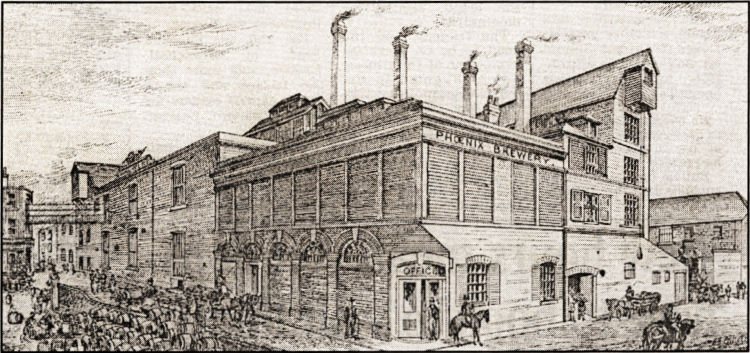 |
|
The former Alfred Leney & Co Phoenix Brewery which once dominated the local
scene in Castle Street, Dover before Fremlins took over brewing, at
Maidstone. THE Phoenix Brewery that once occupied a large area from
Castle Street almost back to Townwall - Street was a major employer in
Dover. |
 |
|
THE Phoenix Brewery that once occupied a large area from Castle Street
almost back to Townwall Street was a major employer in Dover.
This massive complex, the site of which is now occupied by a night club in
the former Granada Cinema building and a multi-storey car park, had a 122ft
high chimney dominating the area.
It was run for many years by the family of Alfred Leney, but dated back to
at least 1740.
Before Mr Leney appeared on the scene the business was owned by James and
Thomas Walker whose family was once prominent in the life of the town.
The brewery is said to have been bought from their estate by Mr Leney in May
1859 when he was only 23 but it is possible the money was put up by his
uncle, James Evenden whose name for about six years was incorporated into
the title of the business.
By 1865, however Alfred Leney was sole owner.
I wonder if there are any modern descendants of the Walker brewery family? I
am prompted to ask because of an interesting find made at a boot fair by
John Neville, who writes to me from
Hayway House, 35 The Avenue, Stanwick, Northamptonshire.
Mr Neville wonders if any member of the family or a historian might be
interested in an old document he picked up in a bundle of maps at the sale.
It concerns a loan and bears the names or signatures of Robert, Elizabeth,
Anne, the Revd Robert, Joseph, William, James and Thomas Walker.
Fremlins
Robert was a magistrate and brewer and James and Thomas Walker appear to be
the brewers who once owned Leney's brewery.
Mr Neville's postcode is NN9 6PT and his phone number is 01933 4606703.
The son of Charles Leney, of Hadlow Place, Kent, Alfred was to marry into
the Fremlin family, also brewers, at Wateringbury, near Maidstone. He and
his wife Catherine had five sons and three daughters.
Working with his sons Mr Leney built up the business, modernised the
brewery and took over the rival brewery, malt houses and pubs of Flint & Co,
of Canterbury.
The company is also believed to have taken over the former brewery and
associated property of Alfred Kingsford, in London
Road, Dover. At one stage, Leneys had 160 public houses in its empire.
When Alfred died, in 1900, 400 people filled St Andrew's Church, Buckland
and an estimated 1,000 people thronged the churchyard for the burial, the
150 wreaths including one from the tenants of
the brewery pubs, in the form of a phoenix - which was also the form adopted
for radiator mascots on some of the brewery's lorries.
Mr Alfred Leney, junior became the first chairman when the business was
taken over by Fremlins in 1926. A beer bottling plant remained in operation
and business also continued as Leney's Table Waters Ltd. until 1950. Alfred died in 1953, aged 93.
Charles Leney was the first of two brothers who ran the Phoenix Brewery
in Wateringbury. His sister-in-law Ann was the wife of Frederick Leney,
Charles' younger brother. Frederick Leney remained in Wateringbury for the
rest of his life. However, Charles eventually left the village in 1861,
about the time his youngest son Alfred purchased a brewery in Dolphin Lane
Dover, which also became known as the Phoenix.
A good account of both the Leney's family history, and Wateringbury's
Phoenix brewery can be found in my book advertised on John's website.
http://www.wateringbury-revisited.net/
I hope this helps.
Dail Whiting.
(Above photo shows Mr. A. C. Leney opening the Dover Carnival in 1938.)
Surviving former brewery property includes the former offices on the corner
of Castle Street and Dolphin Lane and one of the four Dover malthouses.
|
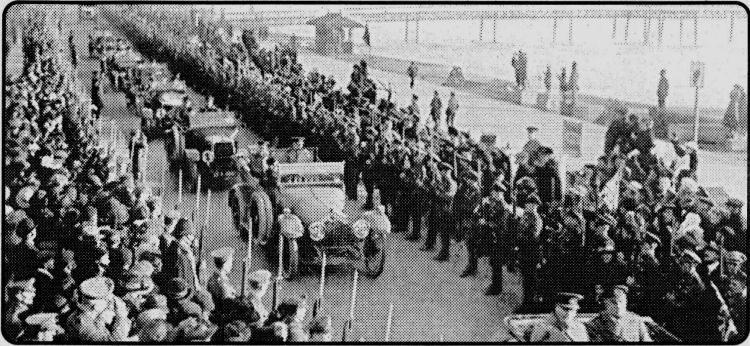 |
|
VICTORY PARADE: Field Marshal! Haig and staff parade on the seafront after
return to the UK after the 1st World War Armistice signing on the Continent.
Behind Is the old Promenade Pier. |
|
THE EPIC raid by the brave seamen of the Dover Patrol and the heroic marines
who stormed Zeebrugge Harbour in the First World War at the cost of many
lives, to shorten the war with Germany is featured in an interesting book
shown to me this week by Brian Marshall, of Cow Gate Lane, Hawkinge.
Beautifully illustrated with many photographs both of the town and port
of Dover, its people and the Royal Navy ships involved in the war, the book
is Dover and The Great War by J.B. Firth, which was published by the
patriotic Dover brewery firm of Alfred Leney & Co Ltd, between the two wars.
I had almost forgotten the book and had certainly lost sight of the fact
that Leneys had published it.
In fact Leneys followed news of the First World War very closely and
helped to pass it on both to its large staff and the public, using office
windows in Castle Street to display telegrams and other war news. Down to
the telegram announcing the triumphant signing of the Armistice marking the
end of fighting the telegrams totalled nearly 4,500.
Recreation
The brewery also threw open its cellars and vaults, whenever air raid syrens
sounded, as public shelters and the picture, below, shows some of those who
took advantage of the service.
Another patriotic gesture was to throw open the Empire Palace Theatre in the
Market Square for the use of troops in the winter of 1916-17. Malthouses at
Maxton were also pressed into use as a recreation centre with baths and
drying rooms.
|
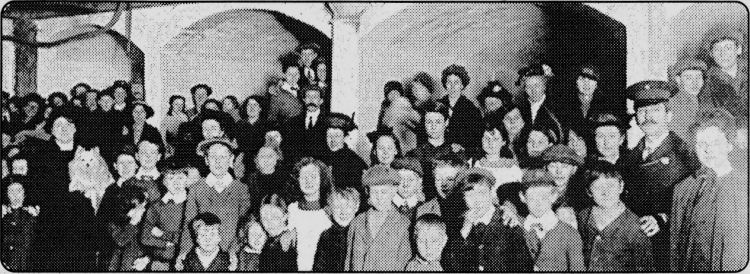 |
|
Above, Leney's Phoenix Brewery vaults in Castle Street in use as an air raid
shelter. |
 |
|
SOLDIERS stand in front of the crowd lining Castle Street waiting to
greet the new Lord Warden, the Marquis of Salisbury, on his way to the
Installation ceremony at Dover College in 1895. Decorations, as at the
Phoenix Brewery yard above, between Castle Street and Dolphin Lane, were
lavish. Brewery men built massive pyramids of barrels and doubtless used
other barrels to build viewing platforms on which to stand behind the
walls.
Information taken from John Bavington-Jones' book "A Perambulation of
the Town, Port and Fortress of Dover", 1906. (Reprint in The South Kent
Gazette, August 15th, 1979.) |
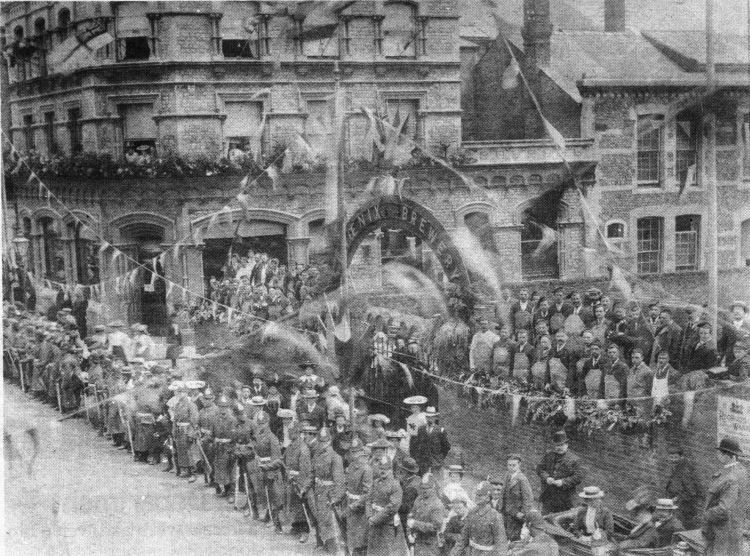 |
|
Prominent feature of Castle Street and a major employer of labour for many
years was Alfred Leney & Company's Phoenix Brewery. The brewery yard -
later the site of the ABC Cinema - and one of the entrances is pictured
above with members of the staff and draymen lined up and waiting the
arrival of a distinguished visitor. On the left at the
corner of Dolphin Passage, is the imposing office block of the brewers,
whose offices were later taken over by H. T. Hawkesfield & Co, the coal
merchants and later by Corralls. On the extreme right of the picture, is
an Army recruiting poster. On the left of Leney's offices was for many
years a butcher's shop. The name over the shop is Holmes.
Information taken from John Bavington-Jones' book "A Perambulation of
the Town, Port and Fortress of Dover", 1906. (Reprint in The Dover
Express, Friday 26th September, 1980.) |
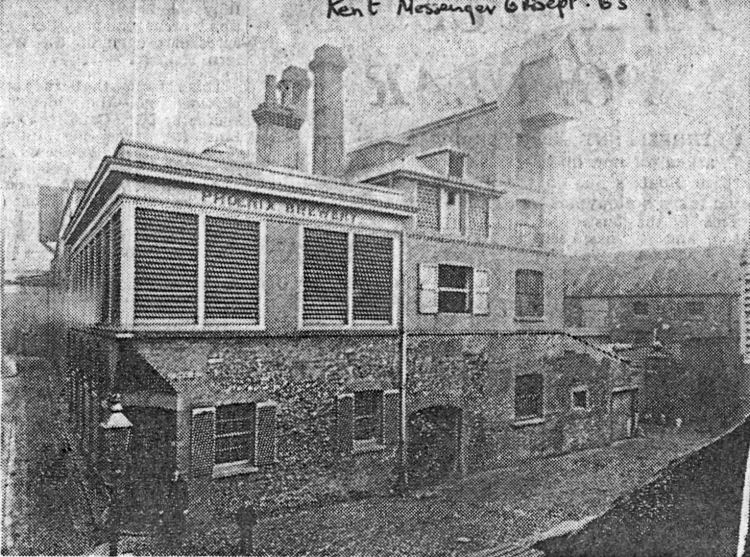 |
|
THE OLD PHOENIX BREWERY of a century ago in St. James' Lane. The
premises, somewhat altered, are still standing today.
From the Kent Messenger 6 September 1963
END OF HISTORIC YARD
ANOTHER part of old Dover is soon to become the target of the demolition
gang.
Fremlins, the brewers, are moving out of the distributing yard in
St. James's Lane to premises in Maxton Road. Their historic yard, once
part of a vast brewery, will come down, and development in conjunction with
the TownwaII Street scheme Is anticipated.
Fremlins are taking over
the one-time Hart's furniture
depository as a headquarters. The distribution depot will be centred
there,
so will their office now in Castle Street, following the completion of
extensive alterations.
CHIMNEY
Fremlins brewery once extended as far
as the present site of the A.B.C. Cinema in Castle Street, and was noted
for its 122ft.-high chimney
stack, erected in 1913.
The chimney stack came down three years ago. Now, in a few months, the
rest of the old brewery buildings will disappear.
Fremlins have long since
stopped brewing and bottling at Dover, and their yard has been only a
distribution centre. But its' final demolition will mean that another
part of old Dover has gone for ever!
|
|
From the Dover Express 6 September 1963.
Old Brewery May Be Up For Sale.
AN area of centrally situated land in Dover - which could very well
attract the interest of developers - is likely to become vacant in the
not too-far-distant future. The property-owned by Fremlins - is the office
in Castle street and the old brewery bounded by Dolphin Lane and Dolphin
Passage. This is only a few yards from the Market Square and at the back
of Dolphin House flats.
At one time the brewery area, then owned by Messrs. A. Leney and Company,
covered over five acres, and the cellars had space for 5,000 barrels.
The
firm amalgamated with Fremlins of Maidstone in the mid-1920's, and brewing
ceased at Dover.
Fremlins have purchased a former depository in Maxton
Road, and have plans for converting it into their new store.
When the move
to Maxton Road is made, the office, and other property, it is believed,
will become vacant for other use.
In the Dover Re-development Plan
prepared in conjunction with Professor Abercrombie, soon after the war, it
was suggested that this was the site for an omnibus station and garage
with access to Castle Street and King Street. Like many other of the
proposals at that time it has not been proceeded with.
A spokesman at Fremlins, Maidstone, asked about the company's proposals, said there was
no person available to comment.
From the Dover Express 26 June 1964.
Brewery sold.
Phoenix Brewery has been sold to Craigton Combined Securities Ltd., a
development company which will be carrying out a large scale redevelopment
scheme in the Market-square and Castle St. areas of Dover.
The site with
its war-damaged buildings, covers an area of about three-quarters of an
acre. The sale has been negotiated by Flashman and Co. Ltd. of Dover.
|
|
From the Dover Express and East Kent News, Friday 27 August, 1965.

Demolition in progress on the Phoenix Brewery site this week. The tractor
is pulling down large sections of brickwork with a wire rope. The cleared
site, which is to be used for a bowling alley, is likely to remain vacant
for sometime due to, the Government's credit squeeze.
As we know, the bowling alley never did arrive, and the site is
still vacant almost 50 years later. That's some government squeeze, I can
tell you. Paul Skelton.
|
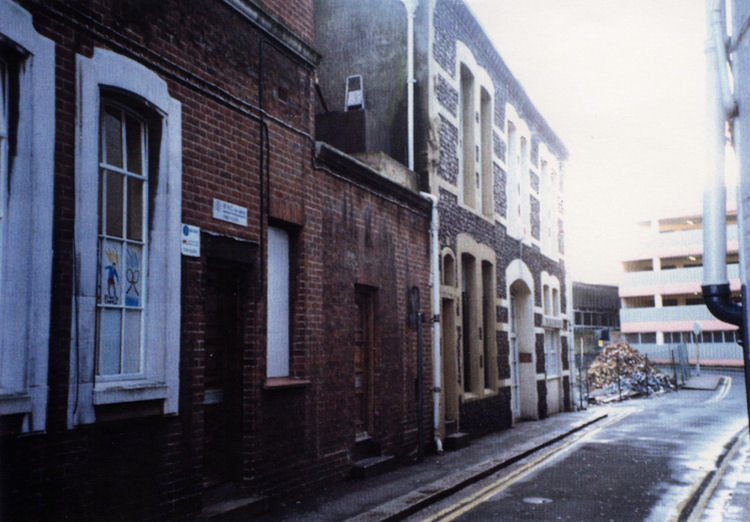 |
|
Part of Old Brewery off Castle Street circa 1995.
|
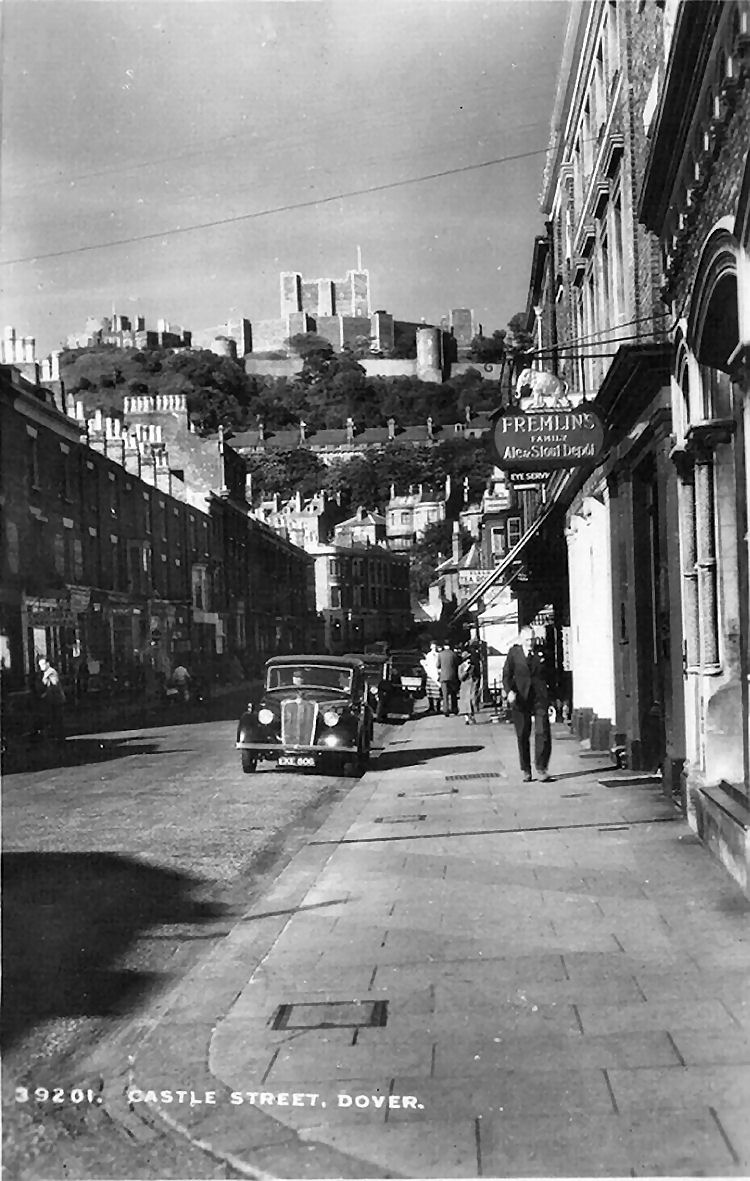
Above postcard, 1938, kindly sent by Rory Kehoe. |
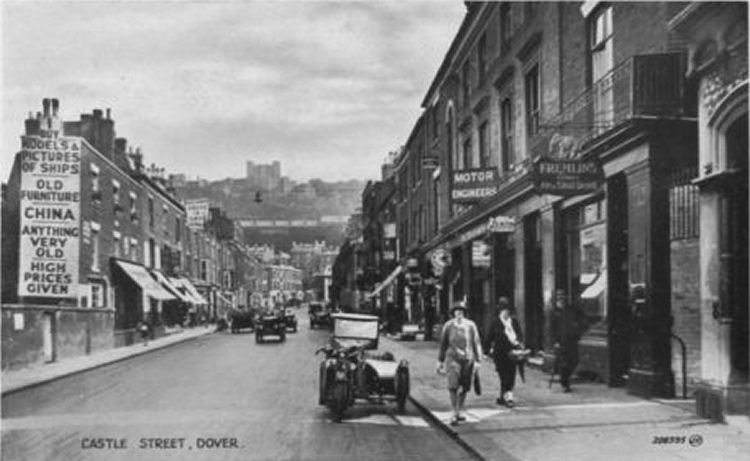
Photo above shows the Fremlins main offices in Castle Street and below the same building
today. Photo by Paul Skelton, 12 August 2009.
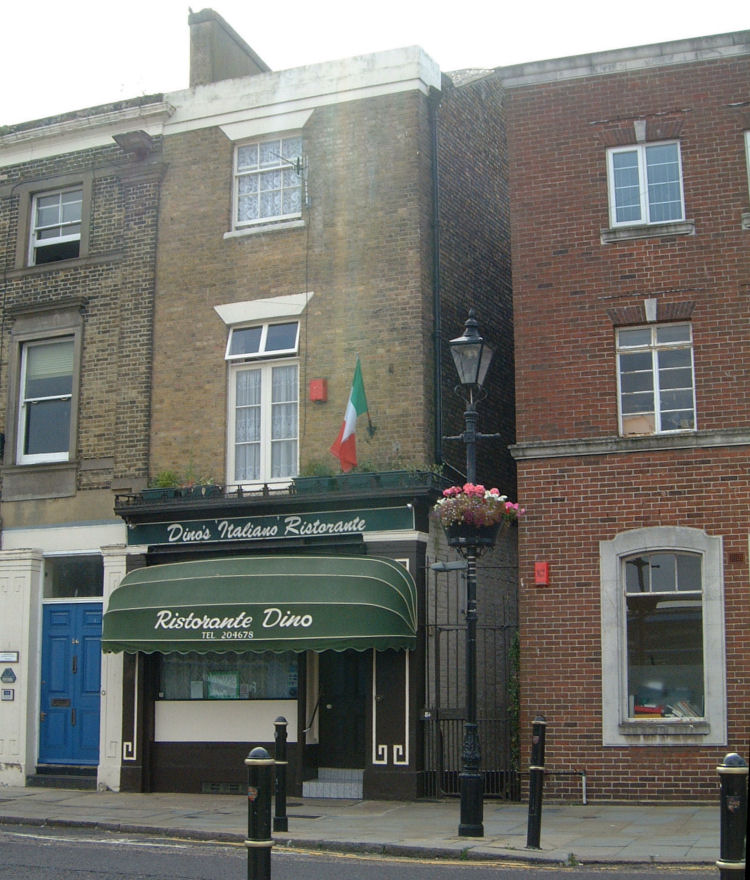 |
|
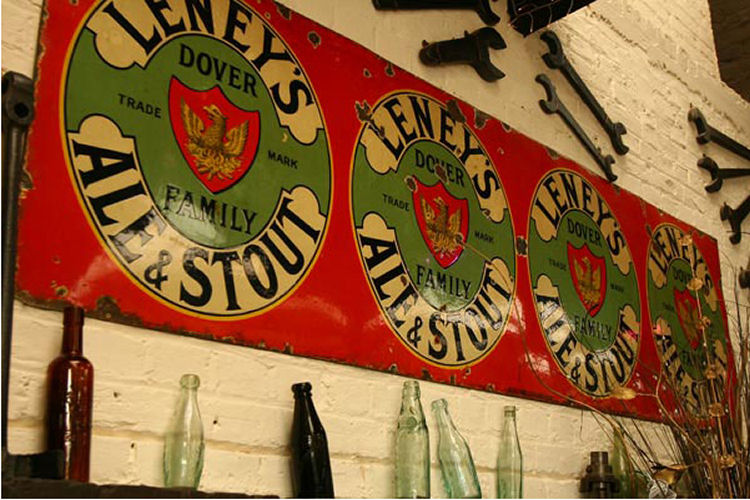
Above photographs shows enamelled adverts housed at "Cullin's Yard." |
|
From an email received 10 May 2013. Dear Sir/Madam
We have just acquired a very interesting Freedom of Dover Box with the
original Velum hand painted scroll inside, we have looked at the history
of Alfred Charles Leney and it is of great interest, the box was made by
one of the greatest Arts and Crafts silversmiths Omar Ramsden, before we
market this remarkable piece on our website I thought that I would email
you as it represents a unique piece of history, I have put the details of
the box below and have included some pictures by way of attachments. I
read your article (this page) and thought that you might know of
someone that may be interested in this unique Freedom Box, we have many
overseas clients that would love this piece of English history but we
would prefer if it stayed in this country, hence this email.
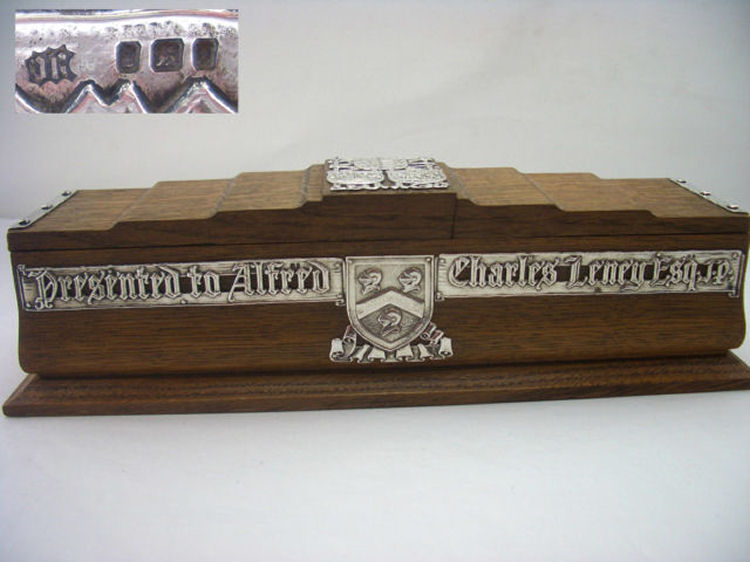
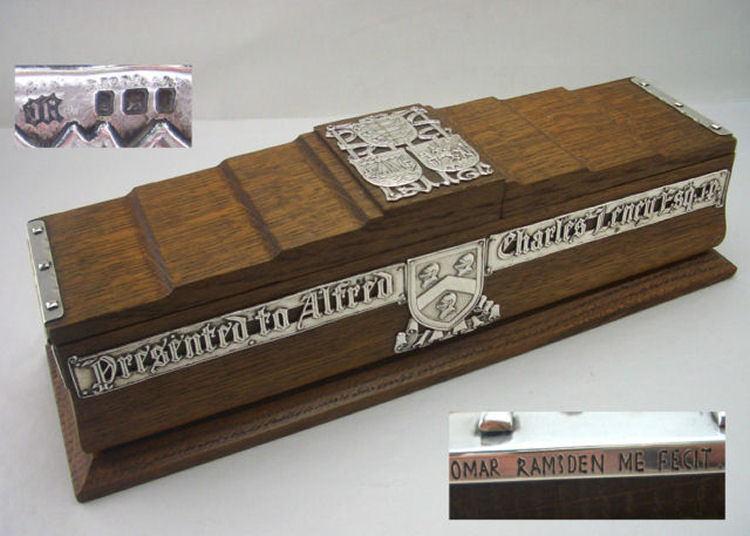
Also listed below is a description of the Box.
Description: - Fabulous and totally unique (one off) silver over oak
freedom box. Stunning item, absolute must for any collector of Omar
Ramsden or Arts & crafts silverware. Carved oak casket with overlaid
silver with cast inscription "Presented to Alfred Charles Leney esq with
the honorary freedom of the cinque port and Borough of Dover".
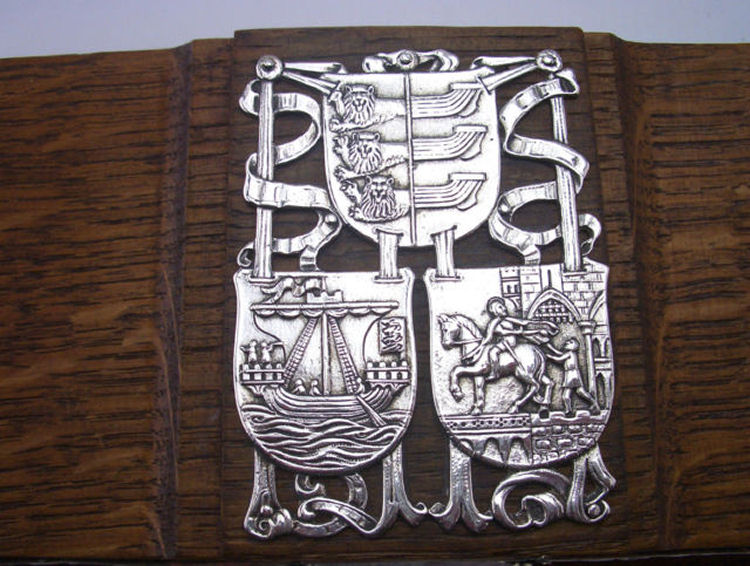
Additional silver plaques to the sides and lid with the Royal coat of
arms plus Dovers crest. Inside the box is felt lined and contains original
velum scroll with silver Leopards head terminals (fully hallmarked by Omar
Ramsden).
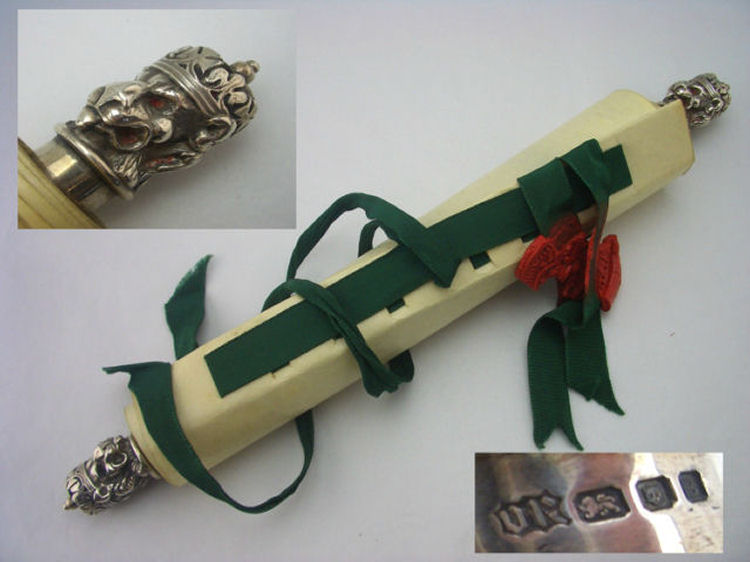
The scroll is hand painted/written in coloured inks, truly fabulous
item.
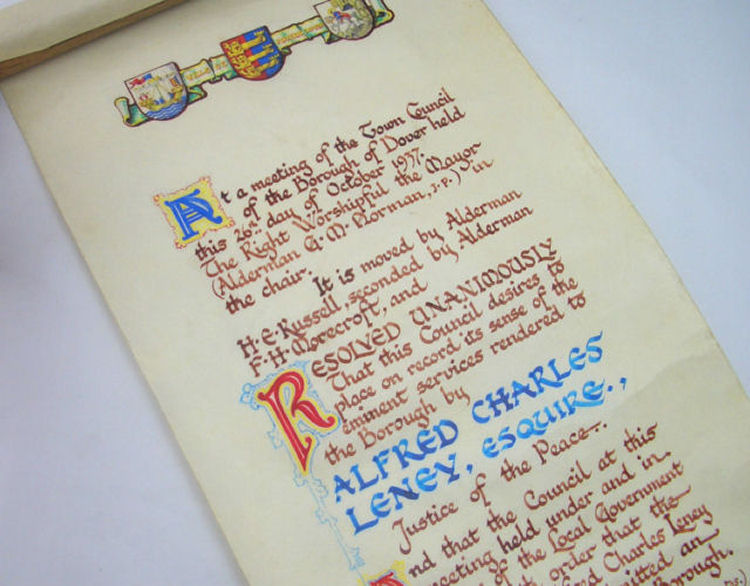
Kindest regards
Peter Collyer
Antique Silver Company
|
|
Photo taken from https://www.facebook.com
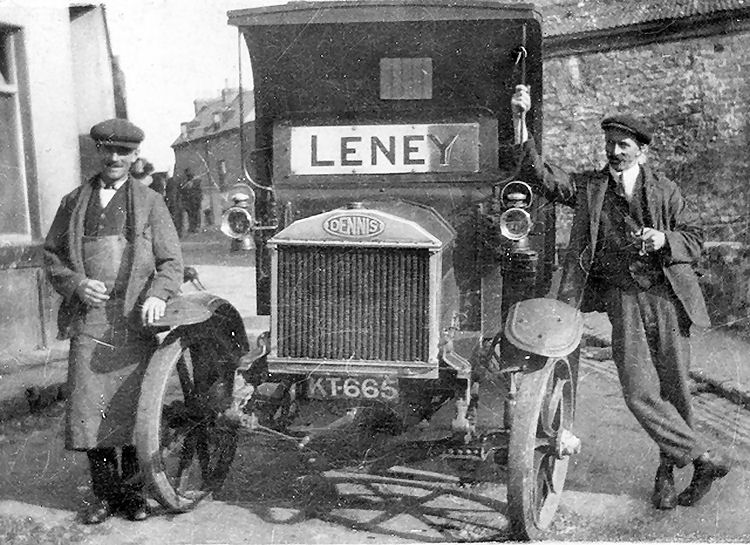
Above photo showing an old Leney truck, 1939-41 area unknown.
|
|
From an email received 2 March 2014.
Hello,
Interested to see this picture (above), on the left in this picture is
my Great Grandfather, on my Mothers side, Thomas Coleman, on the right is
a guy called 'Streeter', my Gran told me this, she did tell me where it
was, if I remember I will tell you, but it escapes me now. I also know he
was a Brewers Drayman for Leney's with a Horse drawn dray before WW2, we
have a number of his 'Road Safety' medals with dates up until 1938, his
horses were sent to France in 1939! so much for WW2 being a mechanical
war. He had been gassed in WW1 and suffered with his lungs, he died in
1941, he did not like the lorry but had to use it, so the picture is
between 1939 and 1941. My Great Grandmother had worked for the Leney
family as a maid, and went back to work for them, at their country house,
after he died.
Regards Andy Kemplen.
|
 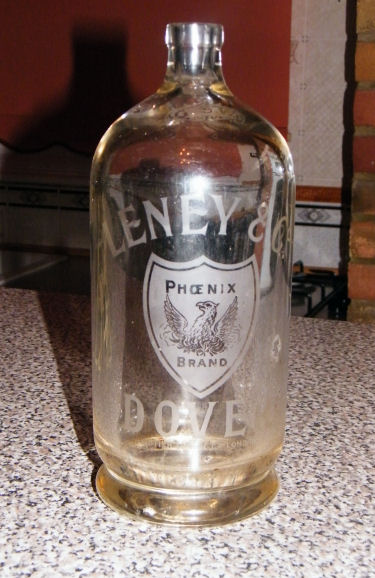
Above bottle kindly lent to me by Ben Skelton. |
|
From an email received 16 January 2015 Dave Ambrose found a bottle top
from A. Lenly Brewers of Dover the other day whilst walking the beach at
Folkestone. Photo of top shown below.
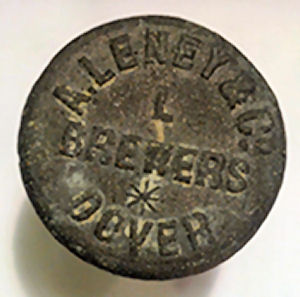 |
|
From an email received 24 June 2016.

Above photo submitted by James Moore. |
|
From an email received 24 June 2016.
Hi I thought I would send you the pictures I have of 3 bottle tops and
a bottle sadly the top of the bottle is missing. These where dug up by
myself by the old Bexhill railway near Sidley, Bexhill-on-Sea.
Mr David Berry.
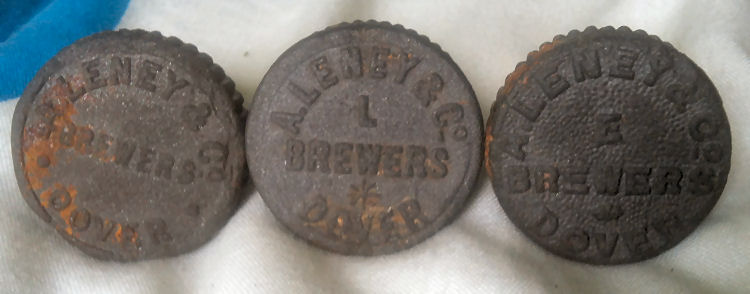
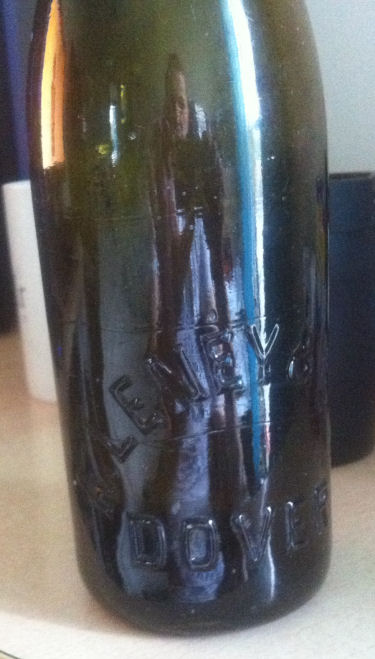
|
|
From an email received, 1 September, 2016.
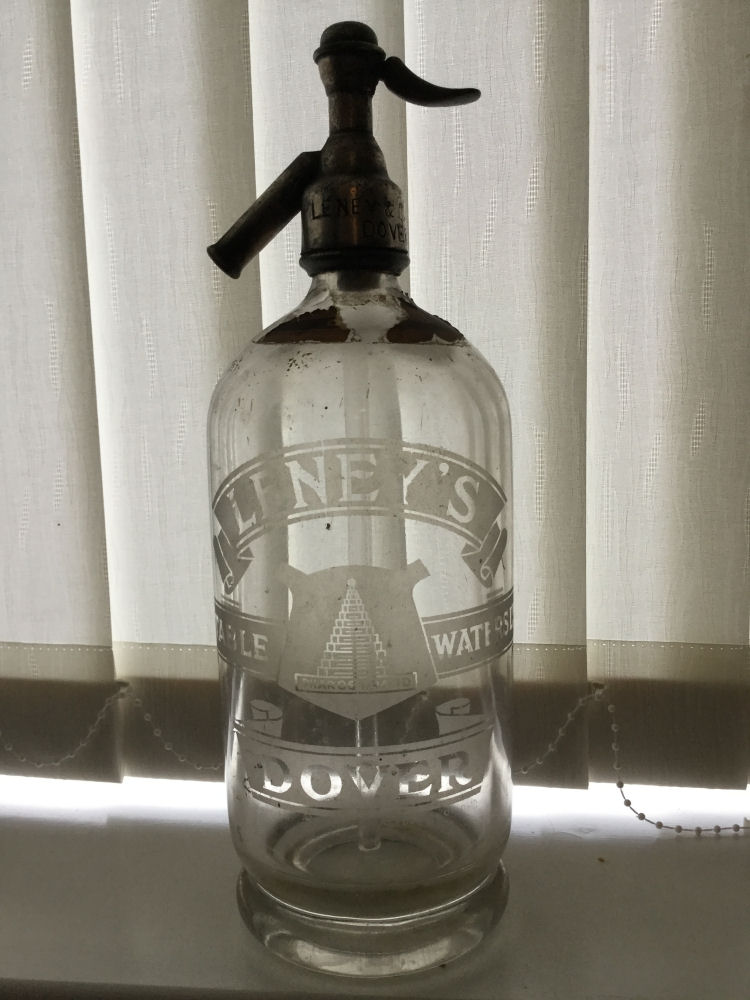
Above image kindly sent from Fra M CC from Belfast.
|

Above enamelled sign kindly sent by Josey Coade. |

Above sign, date unknown, kindly sent by Rory Kehoe. |
|
|
Owned by LENEY Alfred & Co. 1899

 From the Kelly's Directory 1899 From the Kelly's Directory 1899
|

















